In many ways, traveling to Varanasi felt like going back to your grandparents. The world is aspiring to reach the Mars, but Dadu Dida are happy to write me a letter (handwritten, that was a thing!) from their old habitat, happier than words can fathom, continuing with daily mundane while the surprisingly healthy golden house geckos nod in approval.
The Ubiquitous heart of the entire India, Varanasi (also known as Kashi or Benaras) is home to Sri Kashi Viswanath Temple. River Ganga, mother to a substantial population of the world, cordially folds this small landmass in her horse shoe bend. Despite the consecutive change of political power throughout medieval history, the Biswanath Temple (I write it like the Bengalis say it) sustained every gnaw of time and remains a focal point of the Hindu pilgrim circuit of the country. Myriad chapters of history render Varanasi a distinct demeanor at every bend of the street, by the shadow of haveli safeguarding stories of olden days. Traveling to Varanasi feels as if I am to touch the pulse of this old thriving country, India!
In this Varanasi travel blog, I will highlight the reasons why I traveled to Varanasi, how I experienced the old narrow streets of Varanasi, the timeless Ghats by the river, every good and bad aspect of it, and other essential travel tips for a solo female traveler. I made a solo trip to Varanasi. I hope this post inspires you to make that long pending trip to Varanasi.

You will never forget your first time in Varanasi
Why do we follow the ancient pilgrim route to the city of Benaras?
Varanasi is the edifying place to live, an extension of home for every Indian. That old can stay nonchalant against all the murmurs of impending changes, Varanasi is a steadfast living example of that.
I grew up reading detailed illustrations on the streets of Kashi in Rabindranath’s Chokher Bali and many short stories of Prabhat Kumar Mukhopadhyay. Binodini found escape until her lover Behari followed her to the Ghats of Varanasi. The last refuge of every Bengali Hindu widow whom the society had abandoned, Varanasi was the new age Banprastha, when a devout hindu would give up on home and “Songsaar” and recede to the forests.
By virtue of being a pilgrim site, someone or other would take care of the widows. If not, they succumb to the world’s oldest trade in human flesh. The literary references I am talking about are of India as a British colony, not many cared about women’s rights and inheritance. In fact, sending off a widow to Varanasi was often seen as a good riddance, as the path to ascend to the family throne became easier.

I vaguely remember the shooting of the movie Water, a film by Deepa Mehta, which further delved into the issue of Hindu windows’ plight and stirred many controversies, making regular headlines on the morning newspaper. In my mind, Varanasi was this old stubborn head of the clan a city, harping on age old customs doused in misogyny, resisting change. The whole fiasco left a bitter taste in my mouth, making me wonder if I would ever want to visit this old city.
In my late twenties, Varanasi beamed into me with a different charisma. The long stretched Indian railway cuts through the heart of Ganga, biting cold of north Indian winter months (Jarh) settles in, pompous Kumbh Mela celebrates an unforeseen conglomeration of millions of thriving hearts, the sprawling sandbank on the other side of Ganga buries many secrets. The flags on the ghats of Varanasi flutter relentlessly. Varanasi had a mysterious spiritual pull, the lure of experiencing the divine!

I have shied away from all forms of structural divinity throughout my life. They said I questioned too much. But their critique never came with answers I had asked for. Deep down my heart, I longed to conform to the spiritual aura which provides billions of countrymen the much coveted elusive faith. I trusted Varanasi.
While I tiptoe around a possible spiritual beckoning, one thing I was certain of. Meeting the mother river, Ganga. I grew up by her side. In many ways Varanasi was homecoming for me! I have spent a decade living in metro cities devoid of a palpable fluvial flow of an ancient river. My travel quests meet a definitive pause whenever I am allowed a chance to bask by a river, soaking in all her glory!
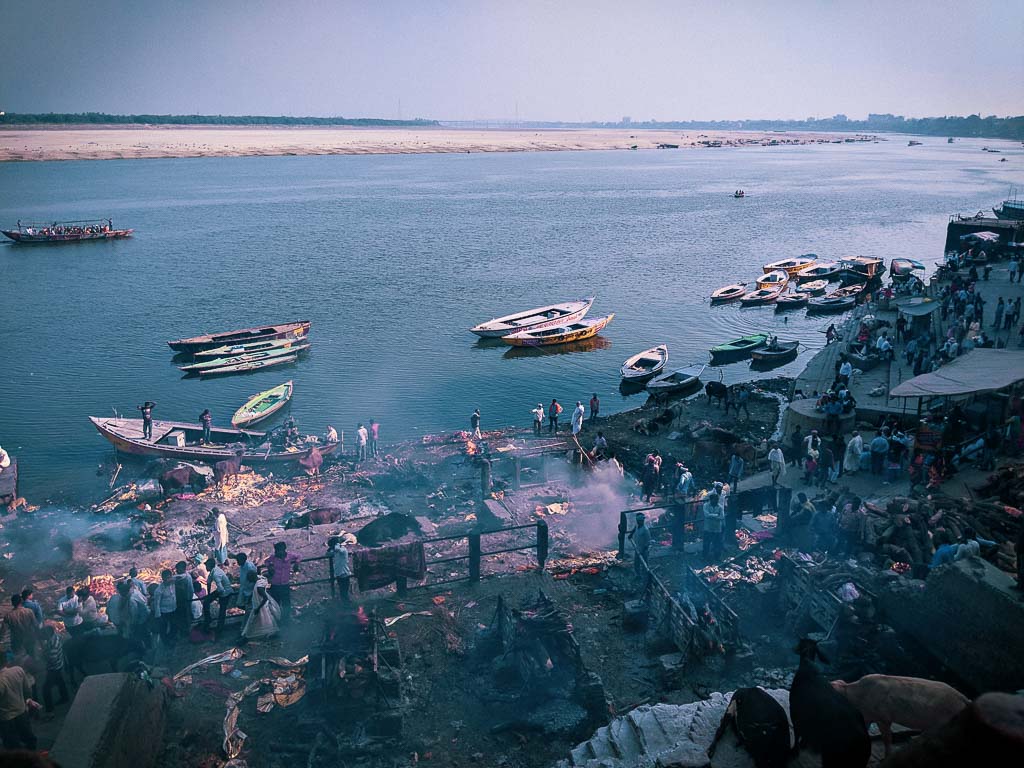
In Varanasi, I did exactly that. In three days time, I explored the ancient ghats of Varanasi starting from Assi and walking till Scindia, after which an old pool appears from nowhere, thwarting the road ahead. I was mindful to not step on the cow dung for as long as I could, then gave up to save my behind from a menacing bull attack. I was skeptical, elated, content, overwhelmed, scared, overjoyed, on the verge of crying on the streets of Varanasi all at once, even after being an Indian raised and bred for three decades in the overwhelming madness that bring harmony to this ancient nation, and I can imagine what it would be like for the first time travelers.
All these happened just before the last Loksabha election of India, possibly the greatest dance of democracy in the world!

Tapping into Pulse of Varanasi: Older than History
By this time, we all know Varanasi’s antiquity had left Mark Twain speechless. Old is pristine when revered and abided by all. In the deep of old, a nostalgic man rediscovers his own self.
For several thousand years, many socio-political developments intersected with the eternal flow of Ganga by Varanasi. One of the premier stops among the Saptapuri (7 cities), senile Hindus traditionally made a pilgrimage to die by the river Ganga. Death by the river Ganga (Ganga Jatra) will put a stop to the cycle of rebirth.
Later, Sarnath first heard the enchanting “Bani” of Buddha, the wise one! Many scholars enriched the history of Varanasi, starting from Kabir and Tulsidas. During Mughal reign, Varanasi acquired the status of an important trade route, making route from the proverbial muslin and silk sarees.

The political upheaval resulted in occasional violent clashes between different diaspora. The neighboring Gyanvapi Mosque to the Biswanath temple stands witness to turbulent times of rampage and rebuilding and making of a political narrative that stirs up controversy every now and then. And you thought only Nuclear bombs are powerful enough to destroy the world? I will write in detail about this later.
To ascend to the throne of Varanasi is equivalent to tapping into the pulse of a sizable population of the subcontinent, for a political party. History proves dynasties fall and rise but all the rulers think alike. It is impossible to travel to Varanasi and yet ignore her politics if you really want to soak in her culture.
My anxiety shoots sky high whenever I sense a mild religious tension in the air in 2020. Varanasi’s fluttering saffron flags, air resonating with hymns for Ganga, mild breeze from the mountain river, and overflowing flow of genteelness of Indian commoners reinstated my faith in peace and sobriety. Even if that is the coping mechanism my mind has adopted, to resort back to chapters of love and humanity.
Did you know? Hiuen Tsiang from China named Varanasi as Polonise in his travel account!

Also read: Travel Guide to Old Silk Route in Zuluk, East Sikkim
How to reach Varanasi
By virtue of being the oldest pilgrimage route, Varanasi had historically been well-connected with the rest of the country with well defined methods of commuting. When we travelled by Rajdhani towards Delhi, the train would make a pit stop at Mughalsarai. In earlier days, you would get down at Mughalsarai and proceed further to Varanasi by a local car or bus. The distance is 18 km.
I thought things have changed but Mughalsarai has acquired a new name, PT. Deen Dayal Upadhyaya Junction (station code: DDU). The double decker Dufferin Bridge connects the other bank of Ganga to Varanasi and carries the historic Grand Trunk Road on her shoulder.
Reaching Varanasi by Road: NH 19 (connecting Delhi to Kolkata), NH 7 (Varanasi to Kanyakumari) and NH 233 (connecting Lumbini, the birthplace of Buddha in Nepal) are some of the most prominent highways connecting Varanasi with the rest of the country.
Reaching Varanasi by Train: Varanasi cantt highway (station code: BSB), kashi railway (KEI), Banaras railway Station (MUV) are some of the railway stations serving Varanasi.
Reaching Varanasi by Airport: Lal Bahadur Shastri International Airport (BNS) is an international airport connecting Varanasi to the rest of the countries of South Asia.
If you are traveling in India for the first time and plan to cover the famed Golden Triangle, there is no reason why you should not visit Varanasi. I took a night bus from Agra to Varanasi and absolutely loved it except for two things:
- I had to board the bus from a highway at midnight. The scary part was I had to wait at a Dhaba where drunk men sat and drooled. I was mostly inside the washroom until a family came with elderly two women.
- At the wee hours of the day, I woke up to a ghastly sound and sudden jolt of steel cutting through another metal. Our bus had met with an accident. A jovial Sardarji was driving and we exchanged niceties the night before. He arranged the best seat for me, the first compartment at the start of the bus and now this! He managed to drive till Allahabad when another bus came and picked us up for the next three hours. I was so startled, I had curled up inside the bunk of my Go Stop hostel near Assi Ghat. It took me to witness another death to overcome my fear. That story will wait.

Where to stay in Varanasi for the first time visitors
A wise traveler would stay as close as possible to the ghats of Varanasi. It is the ghats where Vranasi’s life is centered and painted in myriad hues at every day break. Not two days are same here. During my visit to Varanasi, I spent the entire day wandering about the ghats. I took leisurely strolls, sat at a place for hours, walked past briskly certain pockets, stood still by the never yielding fire of Manikarnika Ghat. The ghats were constant, everything else became a part of fleeting memories of Varanasi.
- Luxury Hotels in Varanasi: Brijrama palace (the only property by the river bank), Taj Nadesar Palace (4.6km off the main ghat), Guleria Kothi, Amritara Suryauday Haveli
- Mid range hostel in Varanasi: Tara guest House, Ganges Grand, Granny’s Inn, Stay Banaras, Aashray
- Budget stay in Varanasi: Rahul Guest House, Alka Guest House, Suraj Guest House
- Hostels in Varanasi: Go Stops, Chatter box, Wander Station, Zostel
- Stay close to the Godowlia market (Dasaswamedh ghat): Fab Hotel Park Avenue, Sai Palace.
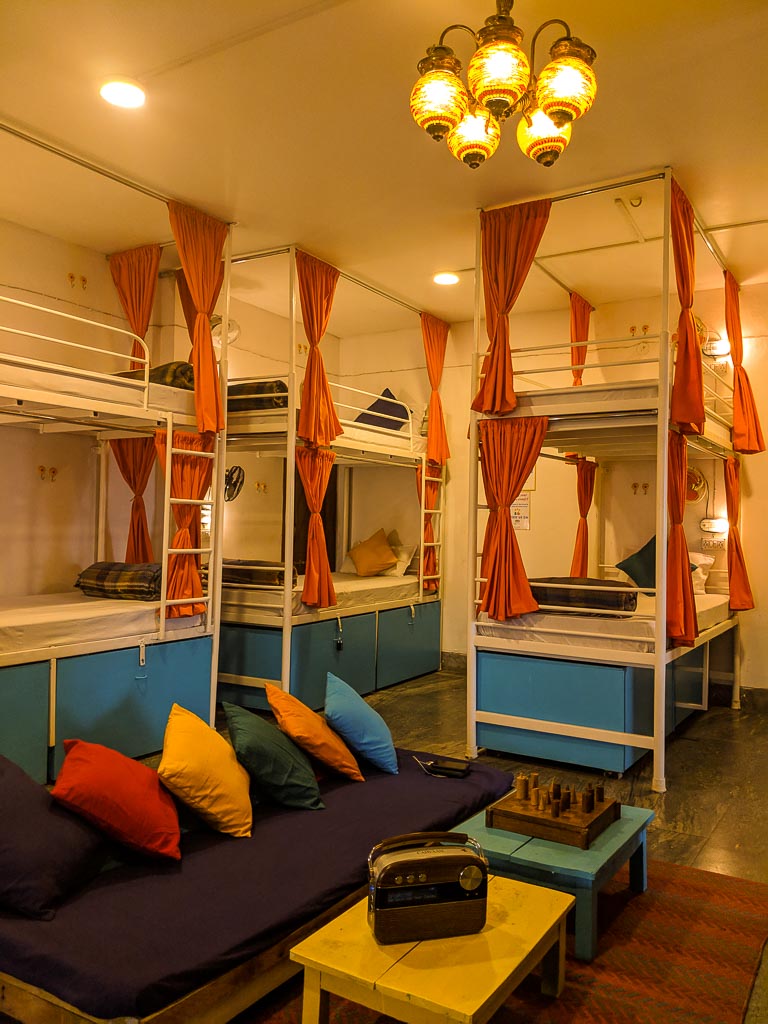
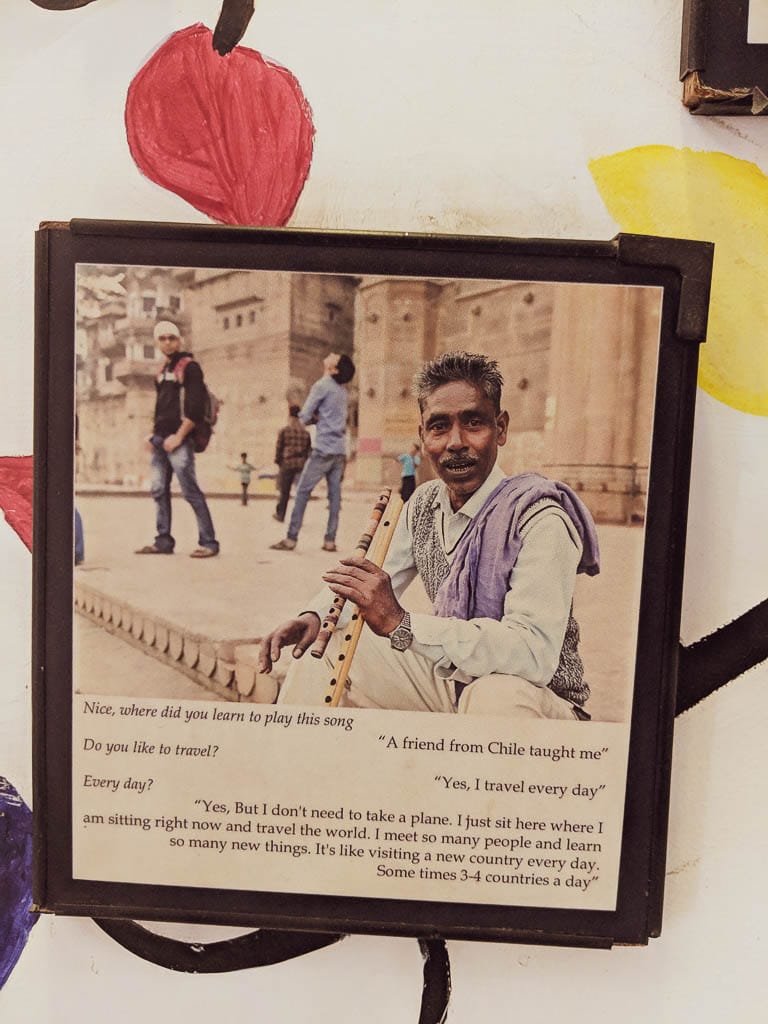
My experience of staying at Go Stops, Varanasi
In Varanasi, Go Stops hostel hosted me. I had stayed with them previously in Agra and absolutely loved their mixed dorm room. Hostels are an emerging concept in India and one of the concrete reasons to encourage more solo travelers to head out.
Gostops had just opened their property in Varanasi when I stayed there. The rooms were swanky clean and decked up with bright vibrant colors. Use of saffron alongside bright turquoise was prominent and bore semblance to the overall theme of Varanasi. It was located at 5 minutes walking distance to Harishchandra Ghat.
Assi ghat is 2 km off Go stops hostel. I explored all the ghats of Varanasi by walking and used to return to Gostops with a rickshaw at night. Besides the dorm room, they had a few private room options as well. Breakfast was included in the package. It had a hearty option of cereals, banana, eggs and toast.
Gostops varanasi had a really nice washroom attached to the dorm room and it was clean for the most part of the day. Upstairs, there was a lounge, a kitchen and an open rooftop overlooking the bustle of the city from a distance. The owner was a fine lady. Her friend held an art exhibition one fine night, walls decked up with beautiful paintings of the Varanasi ghats.
The neighbourhood had a lot of stray dogs, hence I recommend not walking in late at night. This is also the reason I had to give up on an early morning visit to the Biswanath temple.

Best Things to do in Varanasi for the First Time Visitors
In broad lines, you need to walk on the streets of Varanasi, until the narrow lanes become narrower with a dead end, ready to gulp you down! At every bend of the road, you discover a fading part of history. Countless temples, bright murals, humble life, old haveli befitting the adjective “Crumbling Heritage”, and piles of cow dung. All of these perfectly sum up Varanasi!
I stayed in Varanasi for four nights. I had not even scratched the epidermis if the city is a living being.
Here is a list of the best things to do in Varanasi, based on how I experienced the city. I suggest leaving aside all agenda, you should explore Varanasi as she is. Eclectic, nerve wrecking, the quintessential “India is an assault on your senses”. Let Varanasi grow onto you, show you what she wants to and suck you in the labyrinth. You will come out a different man.
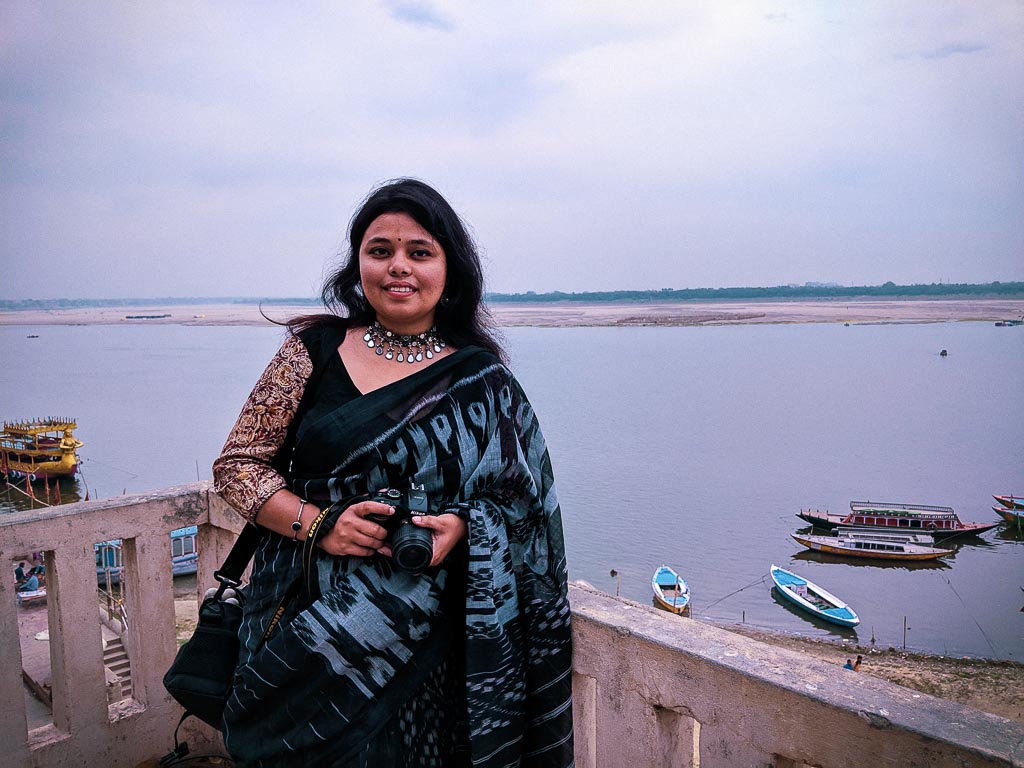
Pay a visit to Ganga, the river extra-ordinaire
What Nile is to Africa, Ganga is to Indian subcontinent. One of the largest and most important rivers of the world, Ganga is the lifeline of north India. You feel the impact of a water borne and old economy by the banks of the river. Life unfolds in myriad ways by the banks. No wonder why the ghats of Ganga is a major tourist draw in the country.
I remember sitting at the Dasaswamedh ghat doing nothing and two middle aged women emerged out of the river. One wore a Shantipuri Bengal tant saree and walked towards her consort wearing a Dhuti. Another one wore a magenta and green striped Chettinad cotton as her mundu wearing consort bagged the wet saree she used to take a dip in the river. They did not speak the same language, but asked for the vermillion pot.
Temple bells rang at a distance. The iconic hymn to the river ceremony was about to start. I was amazed at the vibe of the place. This is the river, I grew up by, and makes me feel at home even when I was miles away.

Boat-ride on Ganges
I prefer to write Ganga, but boat rides on ganges sound so much cooler!
For a fee of INR 1500, a boat will take you from Assi to Manikarnika for a couple of hours. You can share the ride with other fellow travelers. Be ready to bargain. Boat rides are a great way to see life on the ghats.
Life in Varanasi is intertwined with Ganga and the boats rowing on her water. I saw an entire village full of people visiting Varanasi. The men in the group boarded a boat and the women, face covered with Ghoonghat, used another one.
A seat on the parked boat is heavily upsold just before the Ganga aarti commences. Prices start from INR 500 and can go as low as INR 150 if you wait it out till the last moment.
The cheapest ride on Ganga was a boat that takes you to the sandbank on the other side of the river starting from Dasaswamedh ghat. For INR 20, you ride for 20 minutes with locals, visit the sandbank, see a sad camel all dressed up in colorful shackles waiting for children climb its shoulder, and make a way back.
I highly recommend you take this boat ride just before sunset takes place. The last rays of sun kisses the old ridges of havelis standing by the ghats of Benaras. The sky becomes florid red.
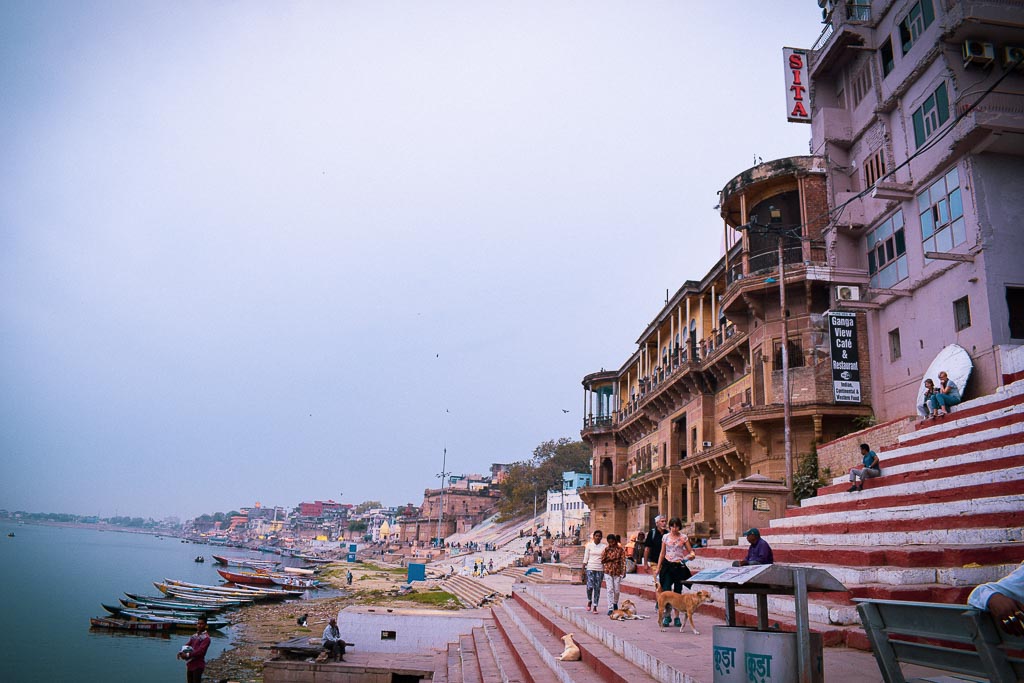
Explore the Ghats of Varanasi
Reserve a whole day to traverse the ancient ghats of Varanasi. I dare say that in that four Km stretch of the land, an entire country resides!
History teaches us every provincial ruler had contributed to rebuilding Varanasi, to mend for every attack that left a bruise to her walls. From the Rajput rulers to the Tamil king and Bengali Zamindars, everyone had left a regional influence on the Ghats of Varanasi, which makes it an absolute delight to explore every nook and corner of it.
I started from Assi Ghat and stopped at Manikarnika Ghat one day. The next day, I started from Dasaswamedh Ghat and stopped at Panchganga Ghat. Among all of these Ghats, Dasaswamedh with constant celebration of life will take your breath away! This is where Apu and his family came and settled after Durga’s death in the book Pather Panchali. This is where Feluda came for a breather after the encounter with Maganlal Meghraj. Excuse me if you do not get the literary reference!
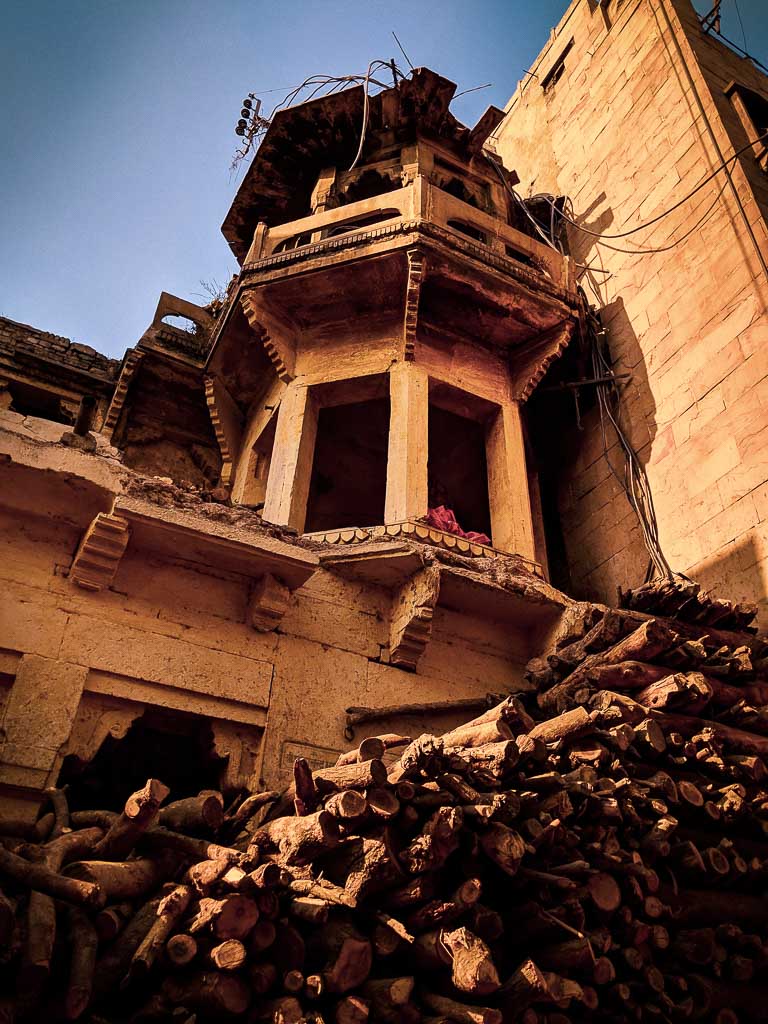
Manikarnika Ghat: the Dance of Death
Manikarnika Ghat with her endless procession of Hindu cremation will evoke an intense emotion. The piles of wood and an eternal firepot await the Hindus once the mortal life succumbs to earthly cycle. Dying and being cremated by the banks of Ganga in the holi city of Benaras ensures your spirit attains “Moksha”. You do not have to return to the world full of sorrow and sufferings yet again with a reincarnation.
It was (and still is) a socially accepted practice to conduct “Ganga Jatra” at the senile age.
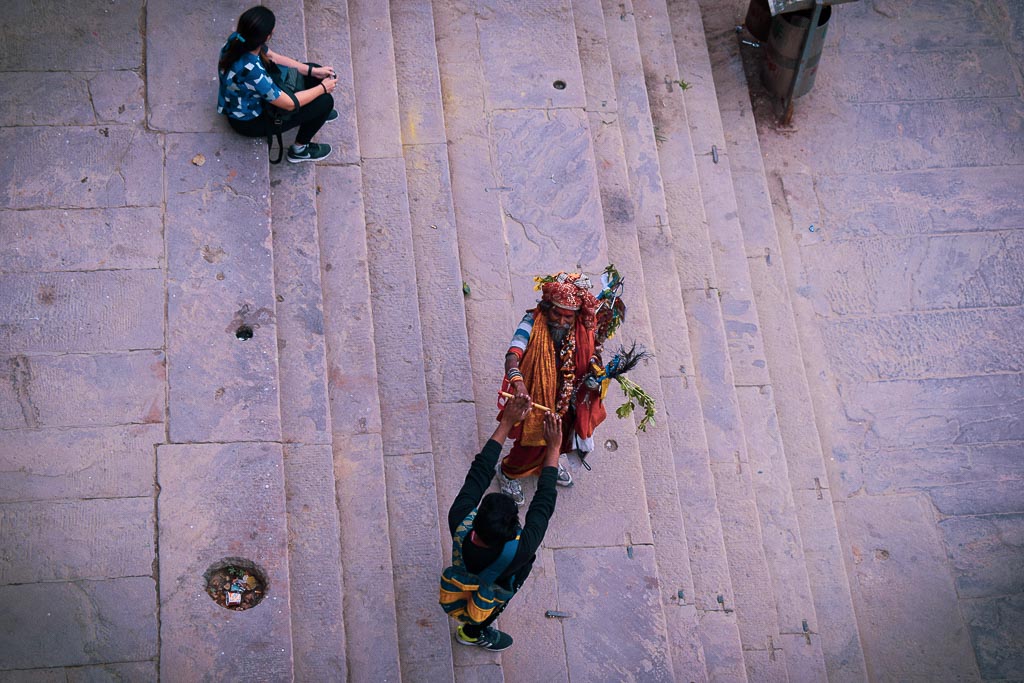
Assi Ghat
Compared to other ghats of Benaras, Assi is a calm and serene spot, perfect to start the morning, This is where morning aarti in Varanasi takes place while a stunning sun rises at the horizon.

Dasaswamedh Ghat: Myriad life of people
I fall short of words to describe Dasaswamedh. Her spirit and positive vibes are beyond this world. Students of BHU come and sit by the ghat and paint. Men and women of different faith come to take a boat ride, or just spend some time by the river. Devotees galore! Pundits sit under umbrella, prepare Kushti, Kundli, tell you what is in hold for future. Dasaswamedh is also home to the most elaborate Aarti ritual of Benaras. It is incredible to grasp the vibe of Dasaswamedh ghat. You have to live the exquisite experience!
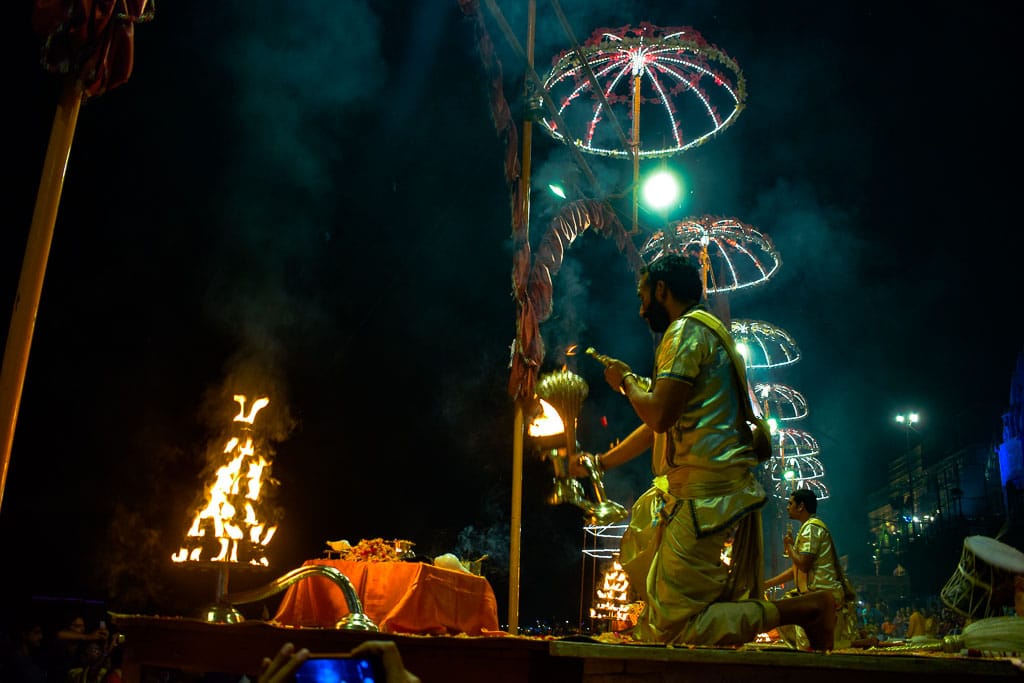
Observe a Ganga Arati Performance
Ganga Aarti is a beautifully constructed performance by the Ghats of Ganga taking place during sundown in Benaras. Every Ghat has its own ritual of Ganga Aarti with Dasaswamedh being the most eloquent and elaborate one. The adjacent Ghats start a little later. In case you miss the one at Dasaswamedh one, you can still catch another Aarti. I watched one at Harishchandra ghat (where animal cremation takes place) at 7:30 pm.
Five or more men dress up in metallic golden attire, usually a Dhuri and a Panjabi, and worship river Ganga with a huge lamp, incense sticks and flowers. Hymns play in the background. I have seen Ganga Arati at Phewa lake, Nepal as well. But live hymn and chanting renders Benaras a distinct edge.

In search of the Spirituality in Varanasi
The holy city. The divine city. The city of Shibthakur. Kashi is spelt with pronounced accents of devoutness. More number of Hindu temples reside in the streets of Kashi than you could count. A prominent “Tirtosthan”, Kashi is a household name in India.
I have seen and read and heard so much on Kashi, I thought stepping into the city will make me regain the lost faith. I was rather disappointed when that did not go as planned. Is it overly hyped? Am I missing something? Looking back, I smile.
I felt I was rather fortunate to get a glimpse of the country, India my home in Benaras. In the month long solo trip in UP, I had a few bouts of a depressive, lonely period. In Kashi, I never had to fear that inner battle. In the crowd of a million or more, I was beautifully guarded even when alone.
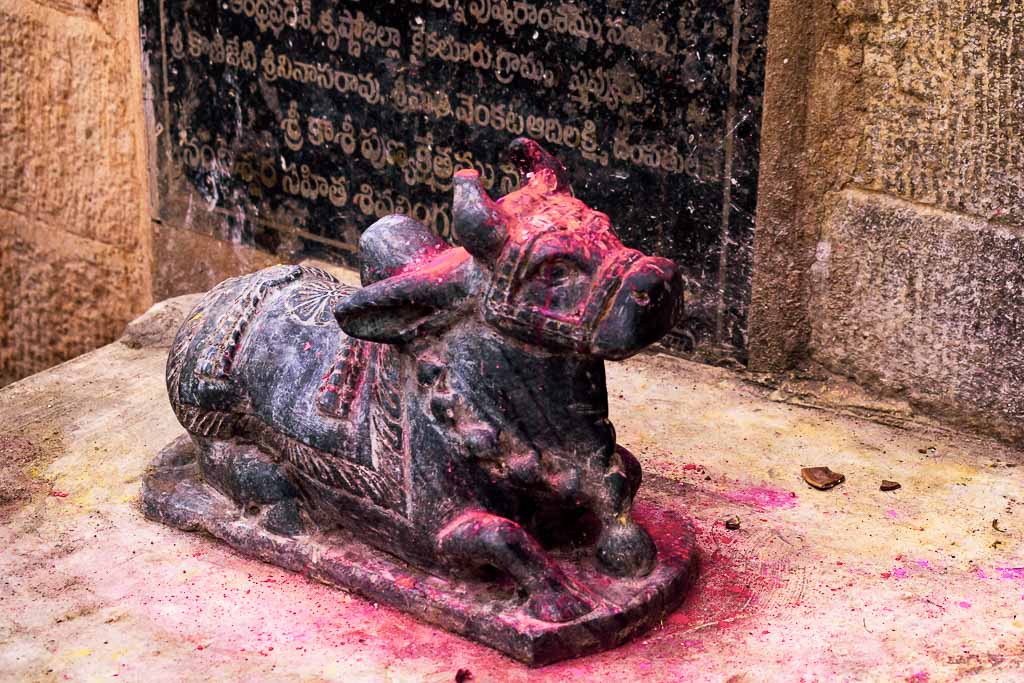
Visit the temples of Varanasi
From countless nameless family run temples to the unique Bharat Mata (Mother India) temple, Varanasi is indeed the divine abode for the faithful.
Sri Kashi Biswanath Temple: Focal Point of Shaivite Philosophy
One of the twelve Jyotirlingams of India, Kashi Biswanath temple (also known as the Golden temple) stands erect since the ages of Purana (Skanda Purana). In thousands of years, there has been many assaults on the temple, the latest being an attack by Qutbuddin Aibak. The temple has been rebuilt and stands adjacent to the Gyan Bhapi Mosque, which was built on the actual site after Aurangzeb demolished the previous temple sanctum.
Millions of footfall await to get a glimpse of “baba”, the Shiblinga. The temple is open to Indians. For foreigners, rules change time to time. To enter Biswanath temple is an experience in itself. You need to stand in queue for long, walk through the famed old lanes eloquent with tales from past. I could not make it till the temple gate on one day but stopped at one of many temples nearby, trying to trace back a Moth run by nuns whom my Dida met during her trip to Benaras!
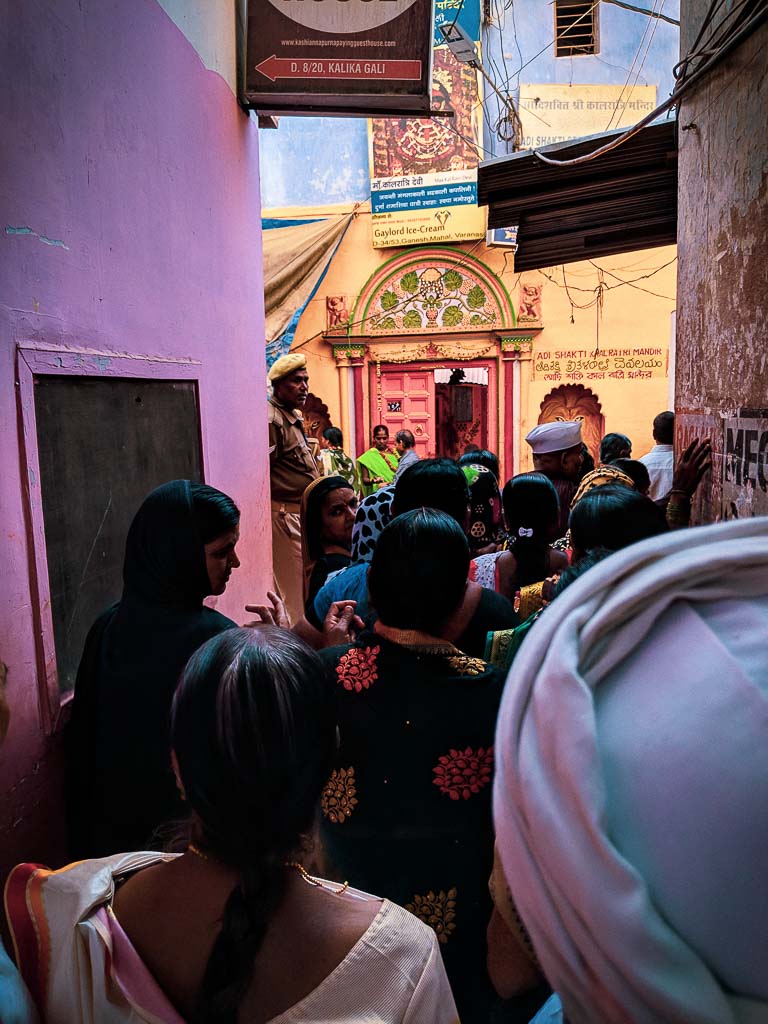
Durga mandir
One of the major Shati peethas and home to Durga Kund, a triangular pond, Durga mandir was constructed by a Bengali Hindu queen of Natore, now a part of Bangladesh. Natore is also famous for Banalata Sen! The temple is built after Nagar style of architecture.
The bright red temple is approached through a lane that is dotted with stalls selling red hibiscus and vermillion. I had spotted a woman in black Hijab standing in the queue as well.
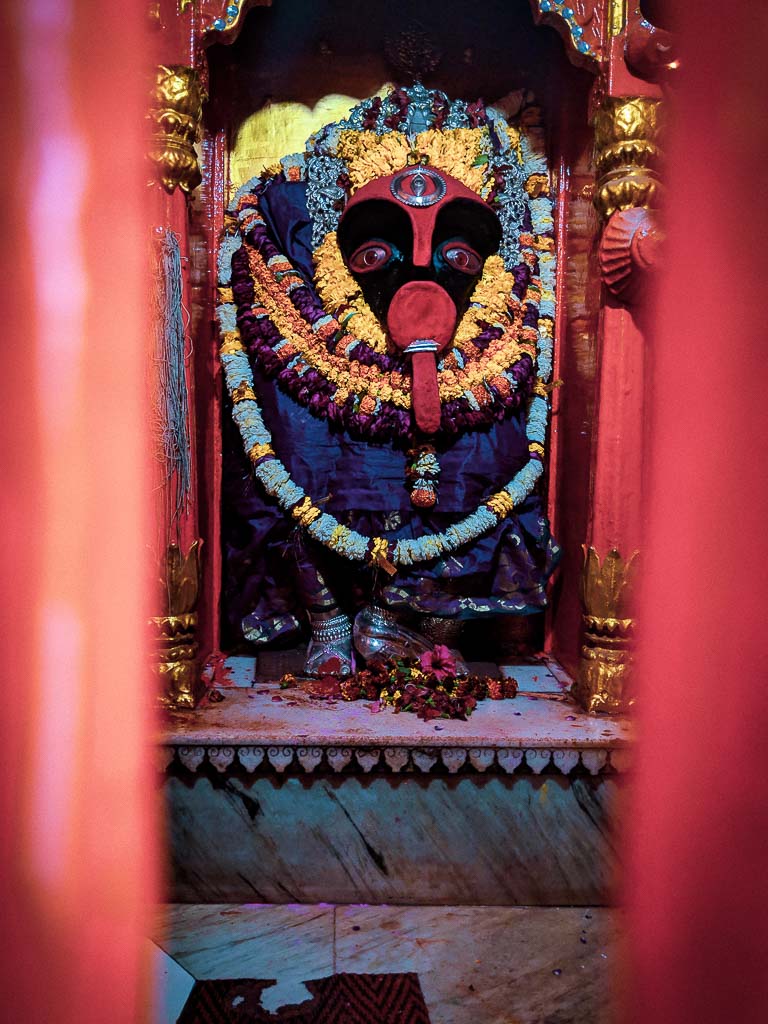
Tulsi Manas Temple
An ode to the poet who write Tulsidasi Ramayan, one of the grandest epics and historical document of the world, not just India. Set amid landscaped garden, the Tulsidas temple is built of white marble and has scenes of Ramayana depicted through figurines.
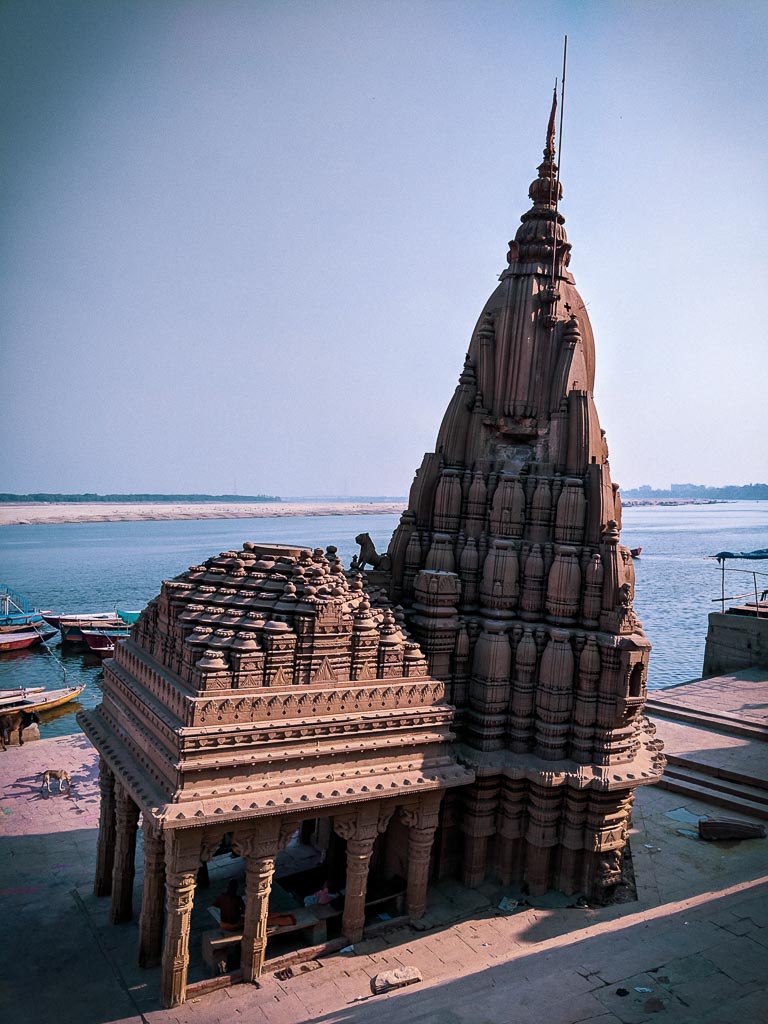
Scindia temple
A tilted temple by the banks of ganga with exquisite architecture. You can not miss it as you will be exploring the ghats of Ganga. Mythological document suggest Agni (fire) was born here.
Sankat Mochan Hanuman temple
An integral part of the Hindu epic Ramayan, Sankat Mochan temple is dedicated to Hanuman and believed to be located where the author, Tulsidas had the first epiphany.
Kaal Bhairav temple
Known to be the “Kotowal” of Varansi city, Kaal Bhairab temple houses the fierce form of Shiva, who presides over the city and lets people in and out! I had seen another Kaal Bhairav temple in Kathmandu valley, Nepal.
Nepali temple
Pagoda style architecture and a distinct make of terracotta bricks, this temple is an ode to the iconic Pashupatinath temple of Kathmandu, Nepal. It is also known as mini Khajuraho for intricate wall carving.
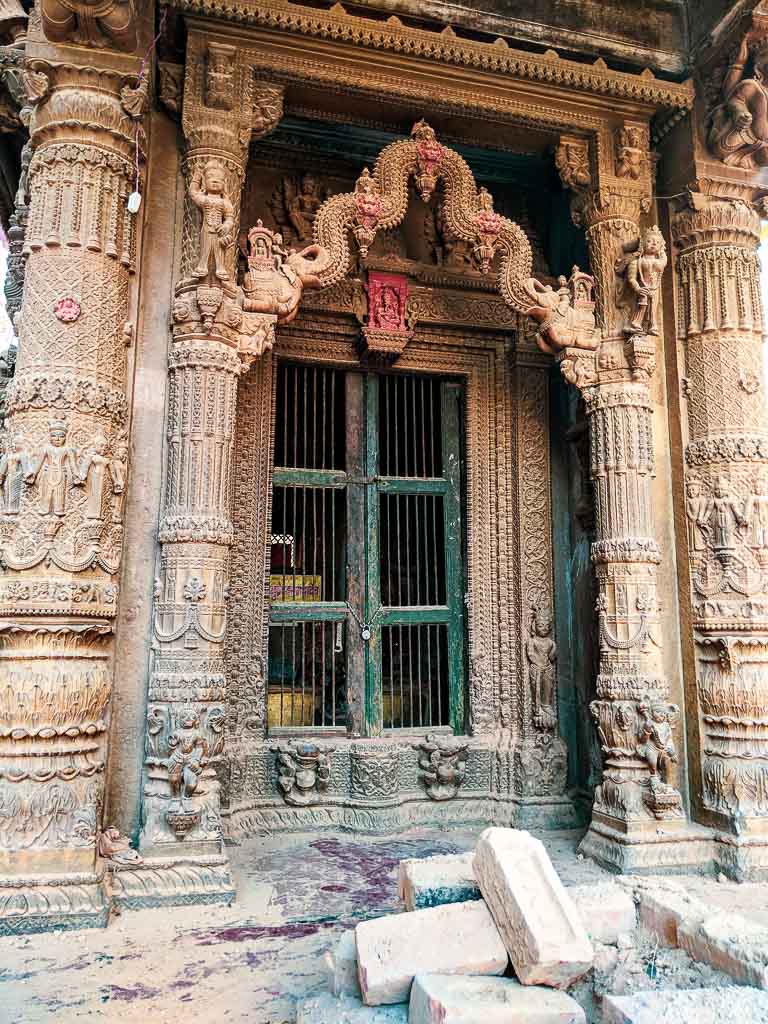
Other prominent temples in Varanasi includes: Kapileswar temple, Tilbhandeshwar , Mrityunjay temple etc. In past, more than thousands of temple have been destroyed in Varanasi with consecutive attacks. It is wonderous how the remaining ones have survived at the face of such hostility and dying patronage!
Apart from the prominent temples of Varanasi, there are countless small temples scattered everywhere in the city. Personally, I liked exploring them more. I do not know names for half of them, but could connect to the shared heritage through numerous literary references. From a Hindu shrine worshipping the Sufi saint Juley laal (along with Goddess Durga) to making of a wooden lion, to a potter exclaiming, “Ma khub rege gechilo, taai baba Kashi paliye ashe” (Mother got angry so Father escaped to Kashi, Mother and Father meaning Durga and Shiv respectively), Varanasi lives and breathes the nuances of a celestial land. It is upto us mortals how we chance a dip into that sea of faith!
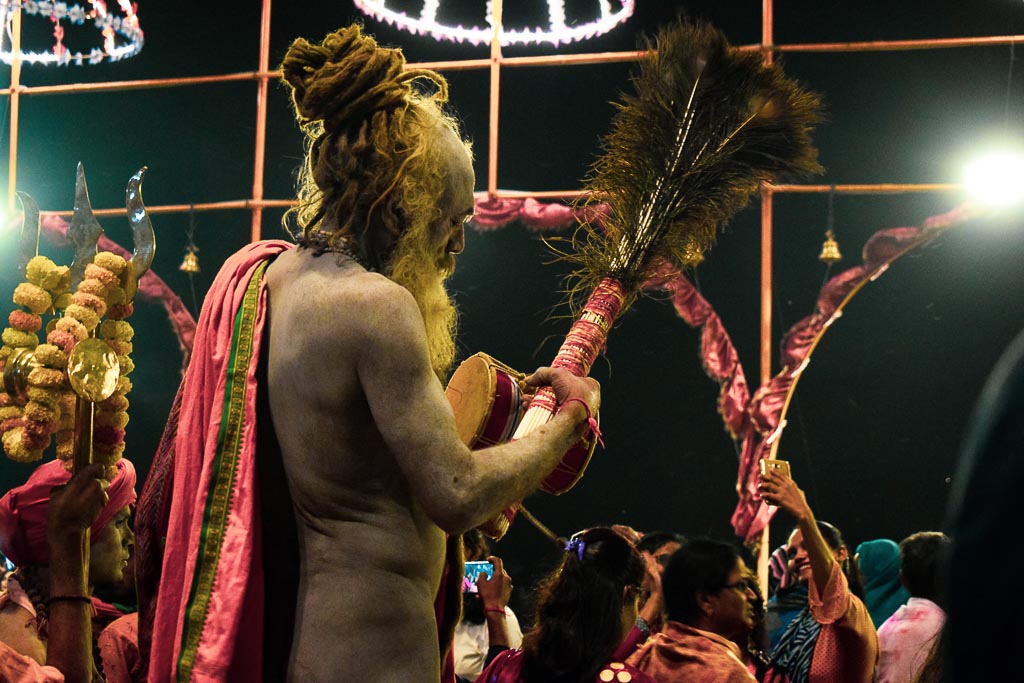
The Sadhus of Varanasi
In India, Sadhus are symbiotic to the indigenous culture of the land. The orange cloth clad group of men (and a few women) leave hedonism in search of deeper meaning of life. A conversation with a Sadhu, if not preempted, can result in surprising life lessons.
I found a sadhu near Assi Ghat, collecting a meagre alm from a woman. In his broken Bengali-Hindi dialect, he was telling her why she should continue with a job, earn money and settle in her life first. Marriage can wait.
You might have known about the mysterious cannibal sadhus of Varanasi, the Aghori sect. First I read about them in Bibhutibhushan’s Pather Panchali. Aghori is still a caste in mainstream Hindu society (a caste marking the already divided Brahmin community). It is said the Aghori sadhu practices Tantric rituals on corpses and thrive on human flesh. Macabre has always indulged human imagination. In Varanasi, the ghats murmur in unison.
Then there are Naga sadhus, the nude saints. I stayed away from them, unable to bridge my apprehensions. Just kidding, I prioritize safety over everything during solo travels, then comes the urge of content creation. I advice you do so too.
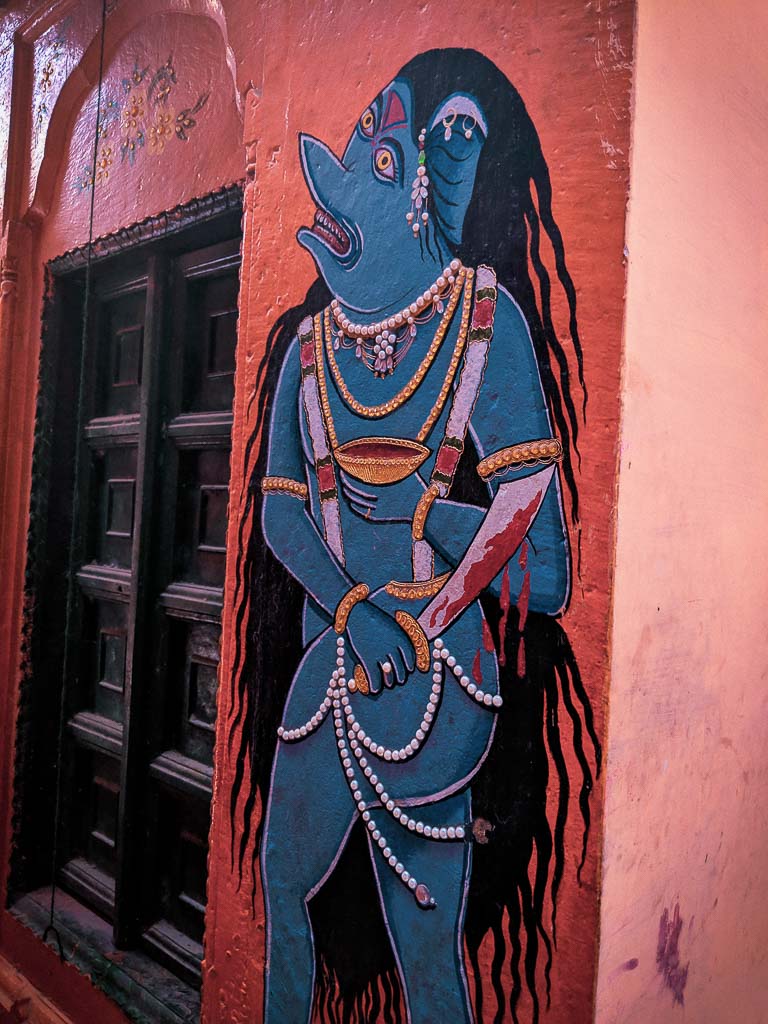
A few locals had warned me not to trust sadhus or take everything they say on the face value. Many men, unable to find proper employment, camouflage as sadhu. Devout pilgrims will give them alms and more as a part of the pilgrimage and that in turn would sustain families back home. Many sadhus had been fugitive in past life as well. Alas, my urban mind finds these words trust worthy.
Experience Subah-e-Benaras
Morning starts on a rather melancholic note in Varanasi. A bright sun appears on the horizon, bedazzling the sandbank and the river in golden hues. It is at the wee hours of the day, Varanasi wakes up and engages in daily clatters. the tea stalls start with regular clatters. At Assi Ghat, another set of Ganga Aarti (morning Aarti ceremony) takes place. The boats start to ply, often decked with a classical singer with a tanpura in hand.
Varanasi has been attributed as the “City of Music” by UNESCO. take an early morning walk along the ghats and you know why!
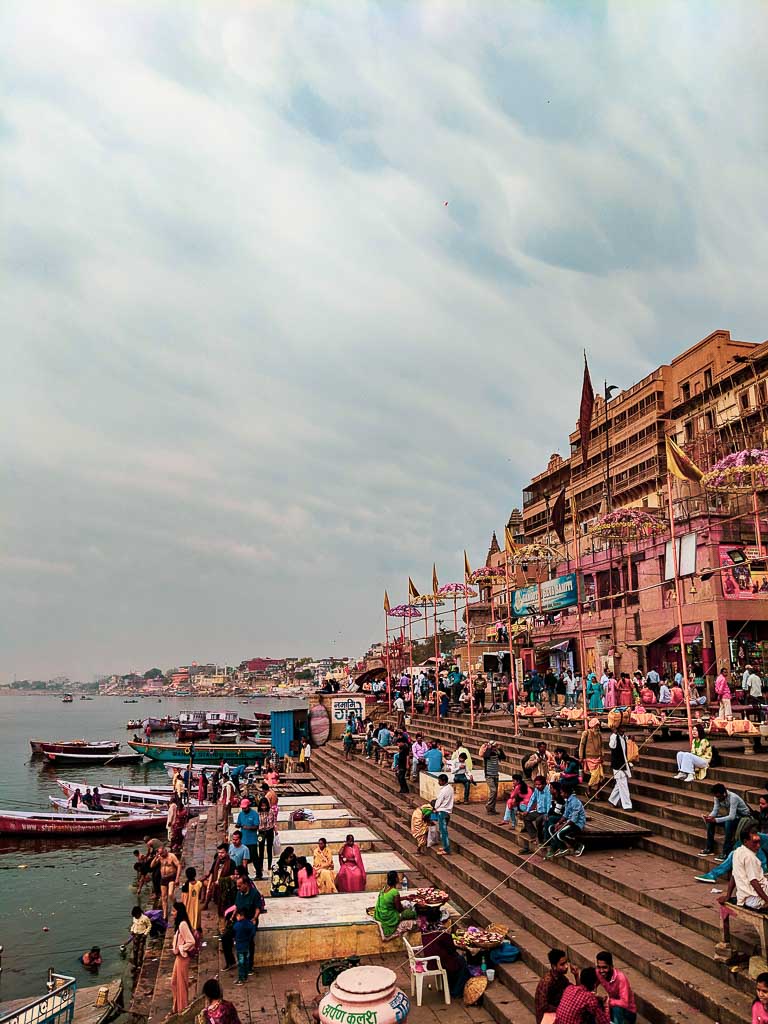
Visit Benaras Hindu University
One of the largest universities of the world, this century old institute started by Pandit Madan Mohan Malviya, an Indian nationalist and scholar, is truly a center of excellence. The university campus acquires a sprawling 1300 acre land, with landscaped gardens, hostels, hospital, temples and administrative offices.
BHU houses the New Vishwanath temple, with a temple Shikhara towering over the city. Arguably it is the tallest temple tower of the world. Entry is allowed for everyone.
BHU also has a museum, the Bharat Kala Bhavan on premises. At the time of inauguration, it was chairmanned by Rabindranath Thakur.
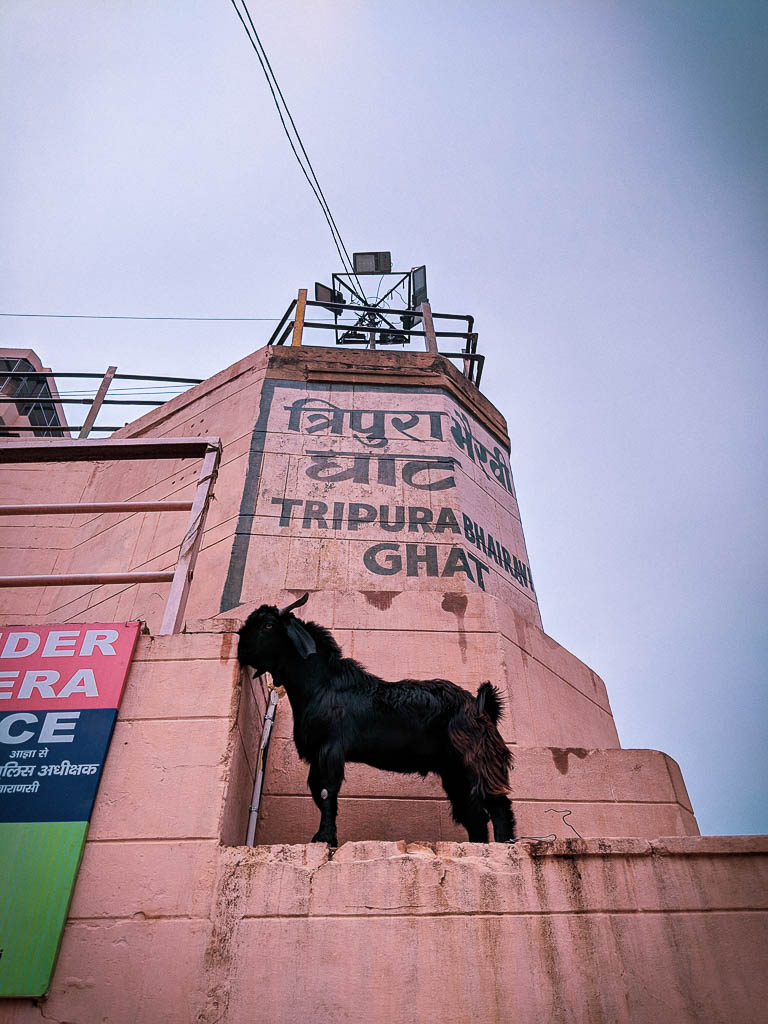
Experience a Ganga Puja
Every time a Ganga aarti starts, look for a small replica of the ganga idol. Worshipped as a deity, Ganga is believed to have started from the head of Shiva. Ganga Mahotsav is one of the most prominent festivals in Varanasi. It takes place in the winter months, after the great Indian festival season is over!
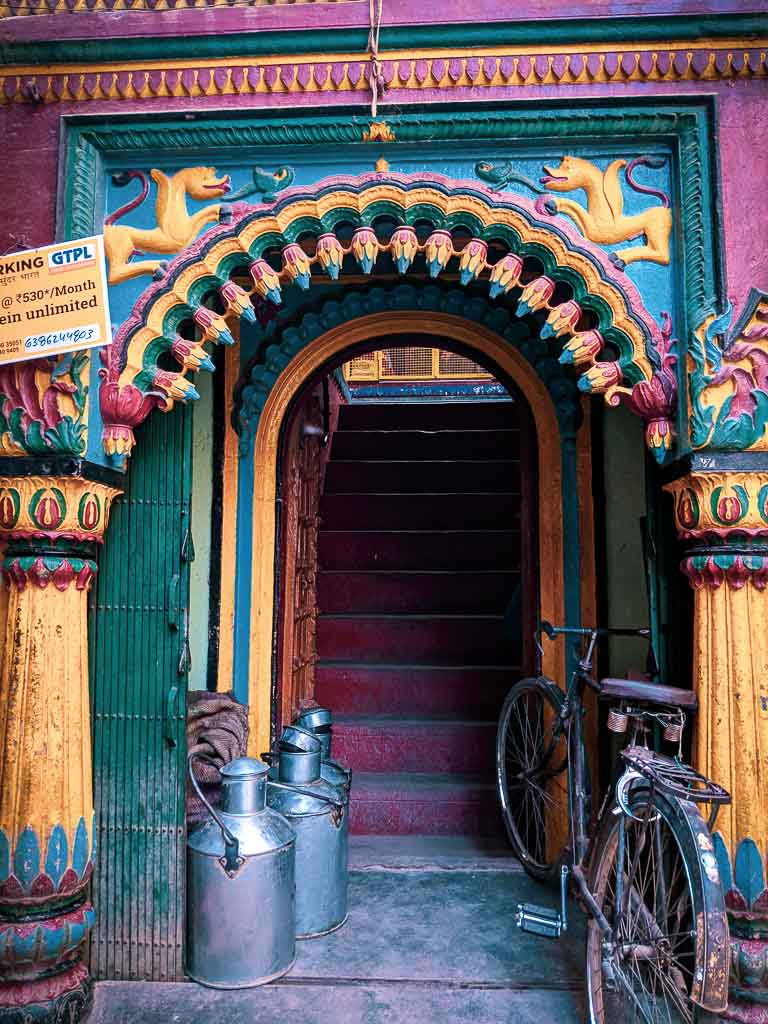
Explore the Narrow Dingy Lanes of Varanasi
Vishwanath Gali or the narrow lanes approaching Sri Biswanath temple is an intricate maze of winding road leading through neighborhoods testify to the fact that Varanasi is the longest surviving continuously habited city in the world. I had to choose between exploring the winding alleys or the beautiful Ganga Ghats. I dedicated each day for one!
To much of my dismay I found the river promenade was being cleared of these settlements. A new road with broader corridor is planned for ease of access to the Biswanath temple. If I set aside the nostalgia, it makes sense. But my silly heart longs for the antiquity these lanes render.
Some lanes were so narrow that it did not have enough space for a cow to turn around! Each of the lane was dotted with beautiful houses, many a times houses built at a later period which ate up one of the old temples. Once at Stonetown Zanzibar, I eavesdropped another man’s conversation that basically was reminiscing the old lanes of Varanasi, a lot similar to those of Zanzibar’s old quarters.
One lifetime is not enough for a storyteller to observe and write all that happens on the old narrow lanes of Varanasi! I would let these pictures do the talking!
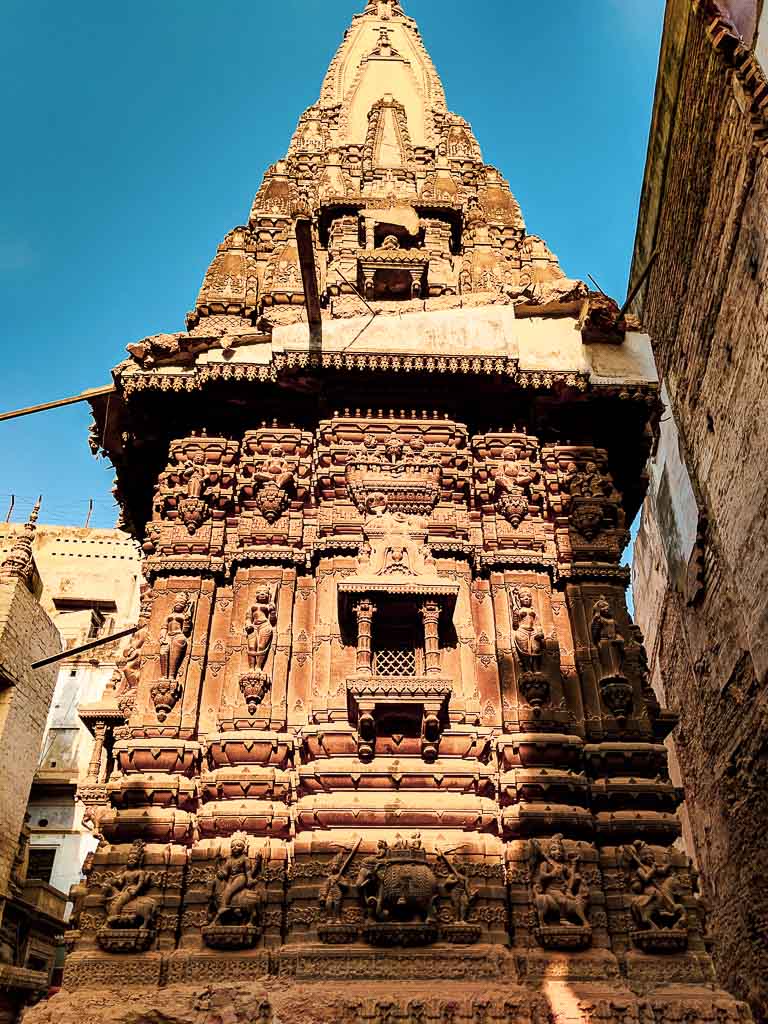
Buying a Benarasi Saree
For a Bengali wedding, the ceremony is incomplete without the choicest of Benarasi saree. One of the most beautiful traditional weaves of India, Benarasi sarees are royal affair! The weaves have detailed embroidery based on floral motives. Those who could afford, would use gold and silver on the fine silk. Opulence, thy name is a pure Benarasi silk saree! This industry was developed by the Mughal rulers.
A pure Benarasi saree takes anywhere between 2 weeks to a year to be completed with all the details gone into making the beautiful piece of art it is! Unfortunately, Chinese looms produce Benarasi lookalikes enmasse and dump the market at a fraction of original price. GI tags and other strict methods have been put in place to safeguard weavers’ rights.
Buying a Benarasi from Benaras involves a visit to the weavers’ colony. You may take a guided tour and interact with them before deciding on which variant of Beranasi you wanna bring back home. My choice is Butidar Zari work Benarasi. The Katans are more famous for weddings.
Meet Bismillah Khan’s family
Not just saree, Bharat Ratna Bismillah Khan’s melancholic shehnai is another incumbent part of a Bengali wedding. While my introduction to shehnai happened at a Biyer Mondop, I looked up the world wide web and learnt how the Ustad singlehandedly brought the folk instrument to the world stage and elevated to the stature of a concert !
Last I heard, his house (C.K. 46/62, Sarai Haraha, can be visited with a guide) has been one of the many being demolished in order to render a facelift to Old quarters of Varanasi. If this is true, it is a paradise lost for our cultural heritage!
Satyajit Ray’s Movie Trail
Watch a Jalsa
I was in Varanasi by the mid March, wee end of winter. Winter also means nigh long classical musical performances by Indian classical raga practitioners. I chanced upon walking into one such jalsa near Assi Ghat, at a sprawling lawn at one of the old bungalows.

Visit a Mosque in Varanasi
Strange it may sound but Varanasi is also home to some of the oldest mosques in the country that testify to the country’s inherent harmonious lifestyle. The Gyan Vapi mosque being the most intriguing of them all, signing off to a time of political upheaval. the mosque was built where the original Biswanath temple stood ground ages back. The Alam Gir mosque by the banks of Ganga is another example of destroying heritage. Photography is prohibited in some parts.
The Akhara of Varanasi
One integral part of local life in Varanasi is to visit the Akharas, the wrestling parlours of the city at the start of the day. Muscly men with scant clothing perform Kusti on sand as onlookers cheers in. I watched one and it reminded me of the movie, Dangal starring Amir Khan. Akhara Goswami Tulsidas, Juna Akhara are some of the long standing wrestling schools in Varanasi.
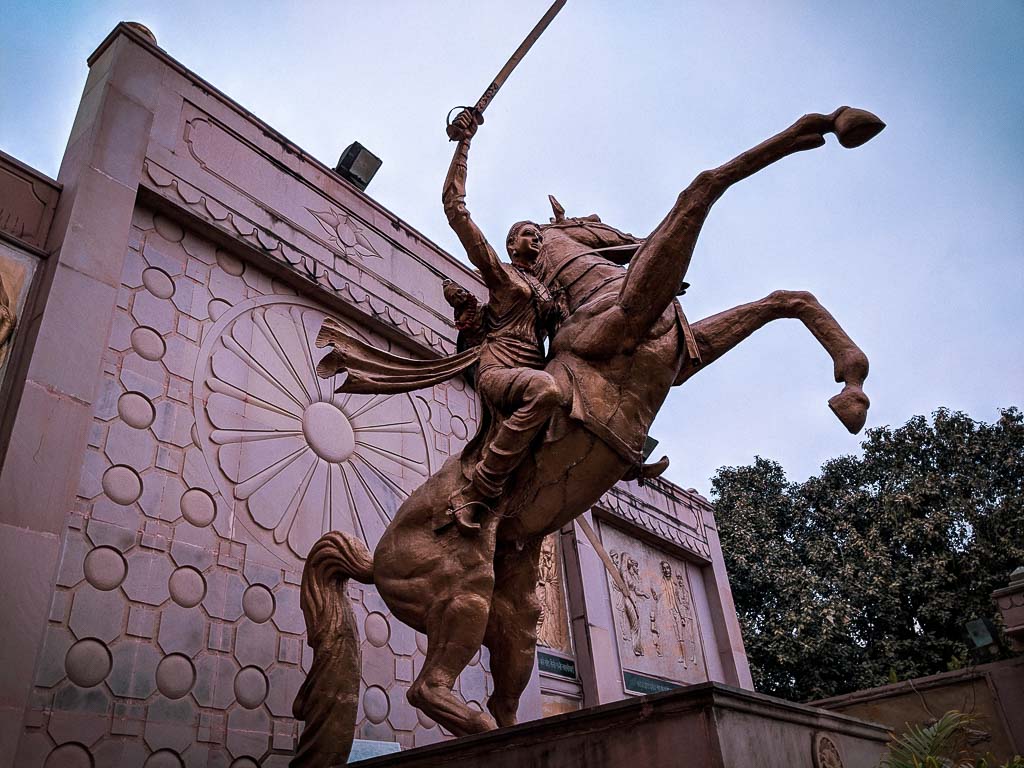
Manikarnika statue
One of India’s earliest freedom fighter, queen Manikarnika, more famed in India as Jhansir rani, was actually born in Varanasi. I serendipitously stumbled upon her birth place which remembers her with an erect statue. It was close to Assi Ghat.
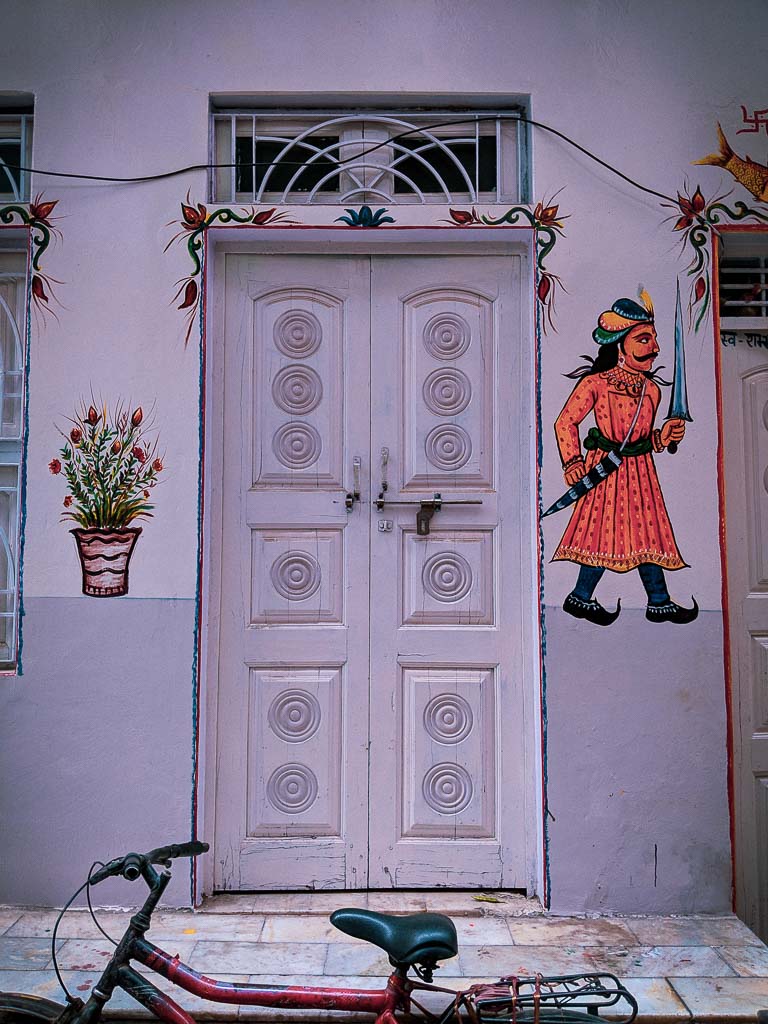
Art on the streets of Varanasi
The doors of old havelis of Varanasi adorn exquisite paint. The walls have intricate murals with an illustrated janitor with swords in hand or a cow nursing her calf. The staircases of a few ghats have myriad colorful paints too.
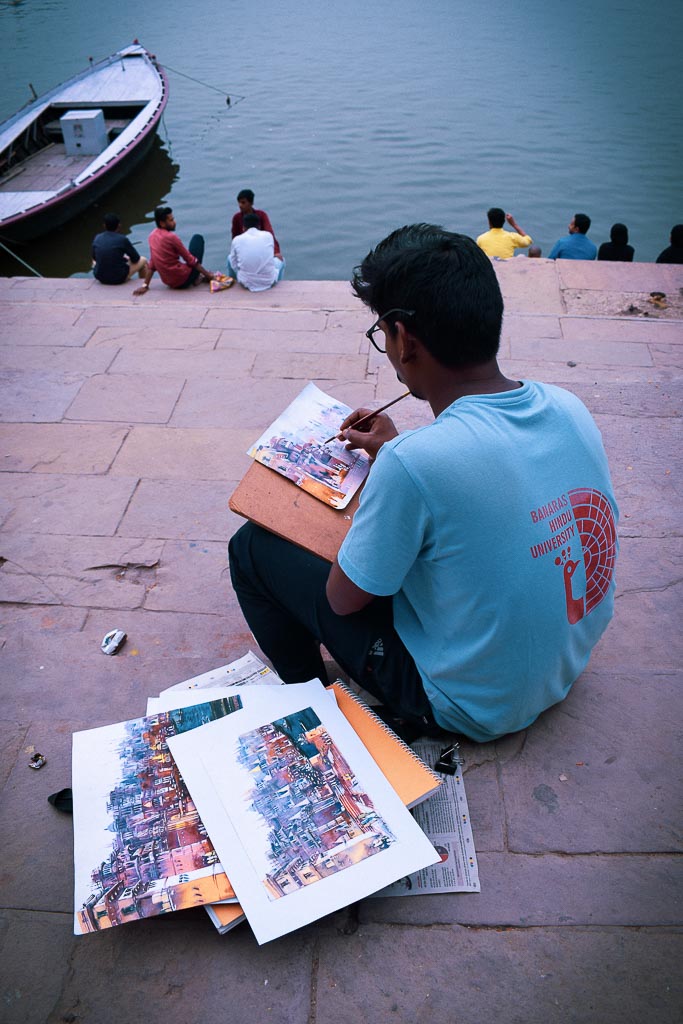
Eat your heart out in Varanasi
The ubiquitous capital of the cow-belt of India, Varanasi is world famous for dairy products. As a result of various cultural crossroads through ancient trade routes, food in Varanasi has been intensely influenced. Desi Ghee comes from the northern strongholds. Bengalis brought in Mustard oil. The Kachoris and Sweetmeats of Varanasi are significant street food items reminding you of the early morning scene from old pockets of North Kolkata neighbourhoods.
I have heard a British instagrammer turned vegetarian (except the thanksgiving dinner back home) while he was traveling in India. “There were so many options in vegetarian food!” His eyes wandered off to the dream of misty mornings of Benaras, where he had started!
I am a fish and rice eating Bengali and I need that in my stomach ideally everyday, worst case once in a week at least, to prevent my human mechanism from collapsing!
It is different in Benaras though! A glass of Lassi is the fuel you need to run the show for the better part of the day! Thick layer of cream floating on the top. Let a Labangalatika or a Rabdi join in the party! You will thank me later!
I am giving you a generic idea about food in Benaras in this section. A detailed blog post on Benaras food guide will follow soon!
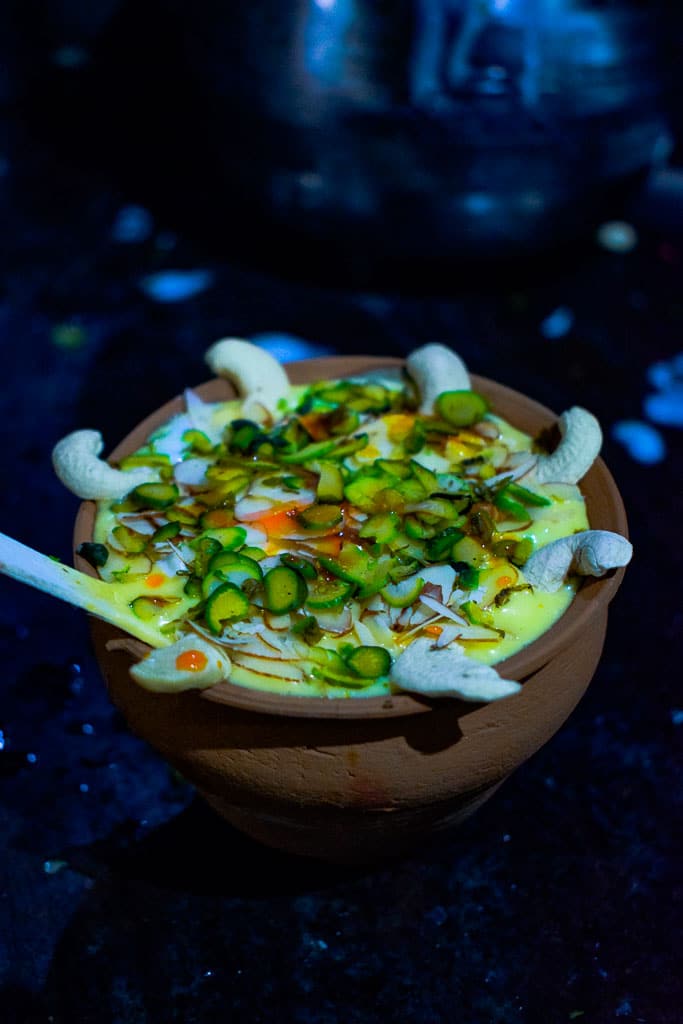
Blue lassi
I walked a labyrinth to reach this beautiful old Lassi shop! Lassi is served in a Kulhad (earthen pot) and topped with plenty of nuts and raisins! There are various types of flavors available. I had two consecutive glasses of lassi and I loved it!
Cute cafes in Benaras
A new clan of cafes are emerging in Benaras to cater to discerning tourists. Vaatika, B-4, TeaQuila, Maya rooftop cafe are some of the better examples. From sushi to pizza, you have no dearth of choice here!
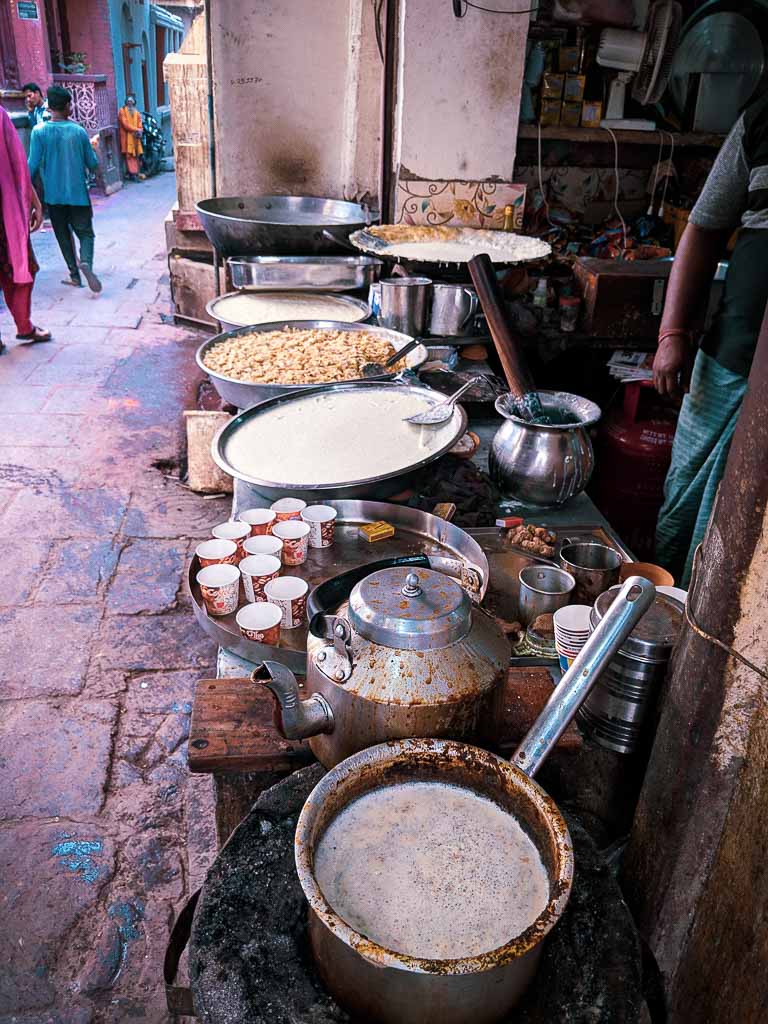
Kadak Chai: Tea in Benaras
India runs on Chai. Benaras is no different! An exquisite tea made of thick creamy milk is served on earthen pot. Tandoori tea is trending as well. Kashi cafe at Assi ghat is one of the most reputed tea stalls of Benaras!
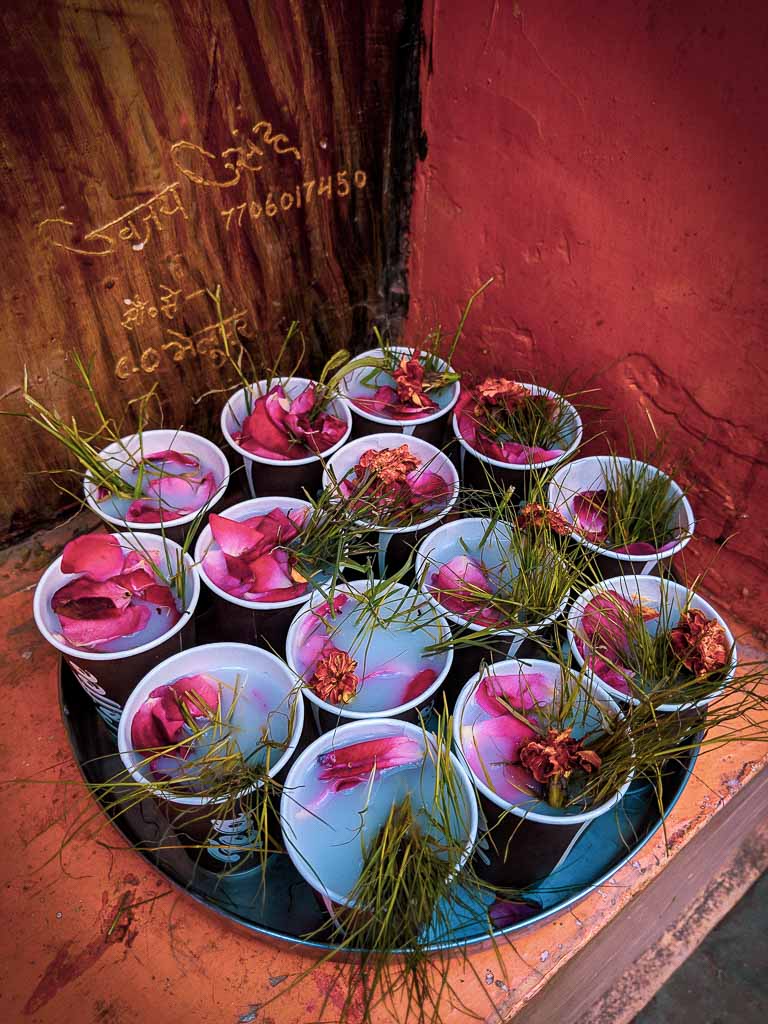
Bhang
This milk based drink has a few “goli” (small balls) of cannabis and renders slight intoxication for the consumer. Take precautions before you choose to drink Bhang but it is no doubt one of the best experiences in Benaras. Many shops near Godalia sells this.
Chats
After Lucknow, in Benaras I had a chance to taste the best of chats! fried delicacies are served with boiled vegetables, mostly potato, bespoke spice mix and green chilies. Generous topping of sweet and sour chutney and thick curd accompanies the base. Head to Kashi chat Bhander to taste some of the best chats in Benaras!
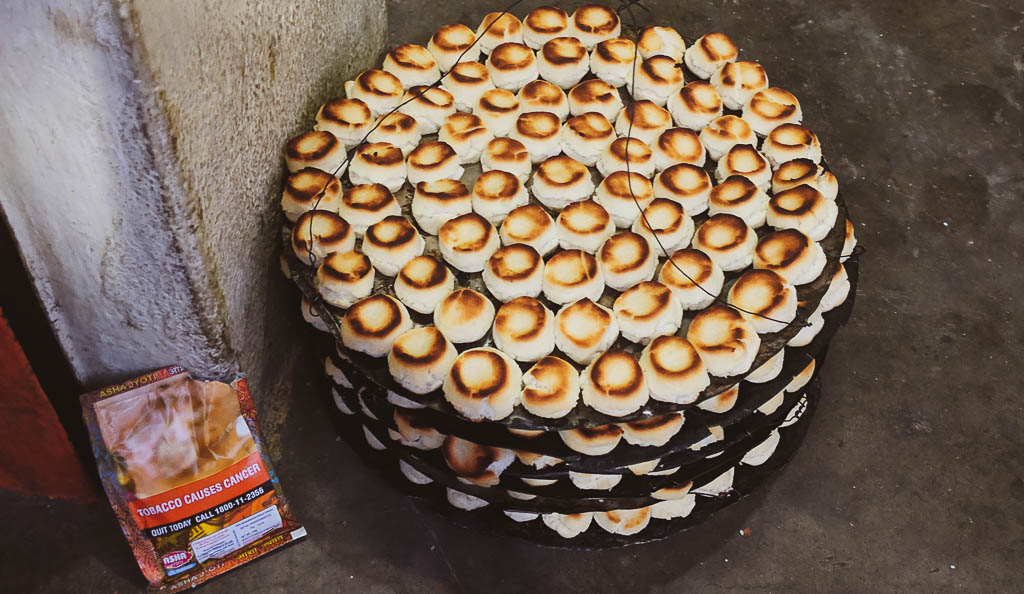
Jalajog
At Jalajog, I tasted a traditional Bengali meal of Masoor daal, potato fries and Posto served with white rice. I also ordered a side of fish but to my dismay I found it to be stale. Jalajog with its humble stature and easy access near Godalia market remains a decent option for vegetarian regional flare.
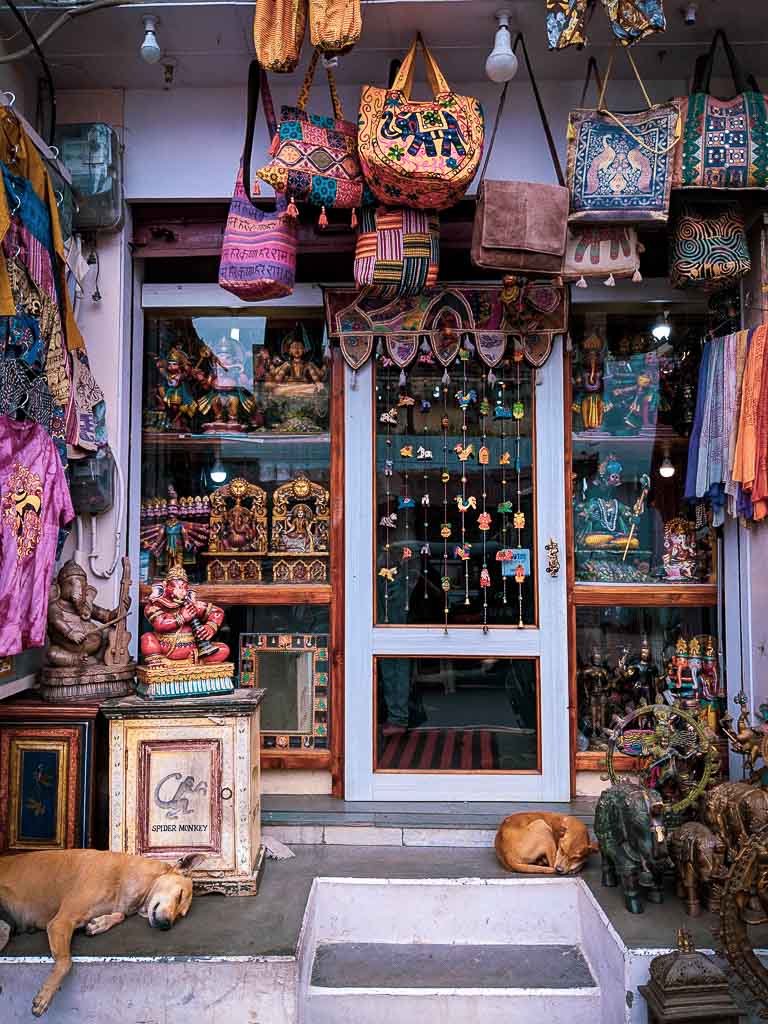
Souvenir and local markets in Varanasi
Godalia market is your best bet to shop local souvenirs from Benaras. From marble stoned Shivalingas to Rudrakhsha garlands and Benarasi silk and various other items, you name it and you get it at Godalia. Look out for wooden toys (my Dida got me some from Benaras), flutes and minakari jewelry are famous takeaway from this old city as well. Devout Hindu take back home water of ganga, straight from the ghats.

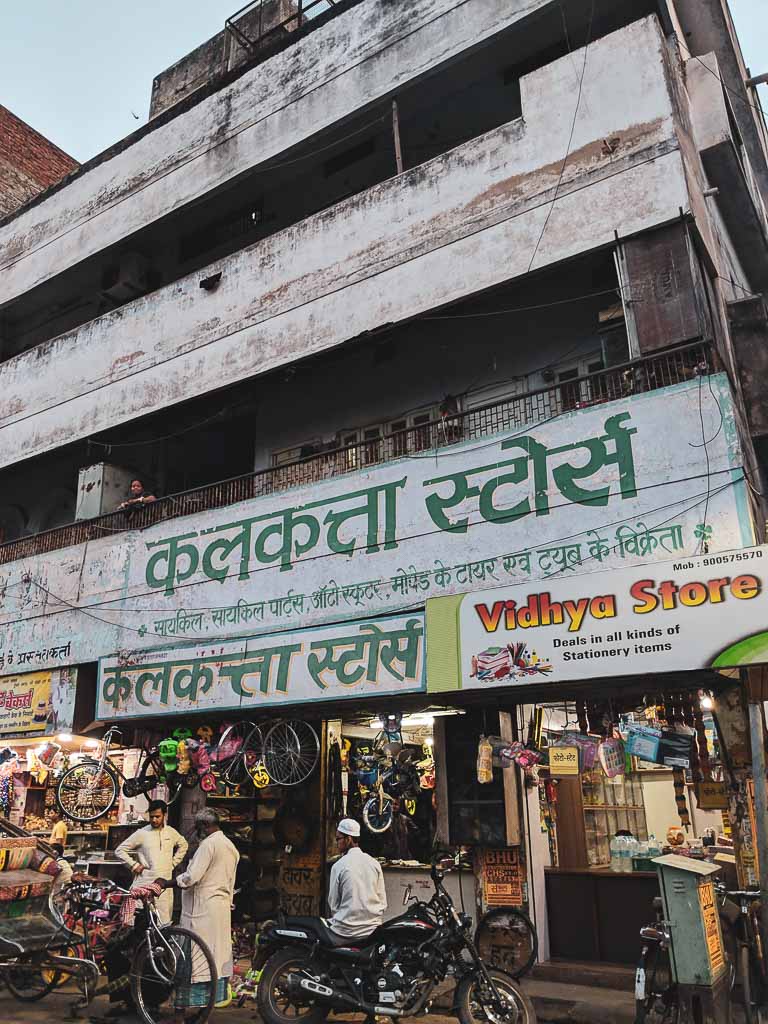
Festivals in Varanasi
I had a chance to be there in Varanasi just before Holi. Vibes go up a few notches at the advent of a festival in Varanasi! For example, Holi was scheduled on 20th of March but people started with celebration from a couple of days before! There were deities, makeshift tents, Bhandaras, Satra, lights and laughter. It is indeed an experience to witness a festival in Varansi, albeit with all guards in place if you are a solo female traveler.
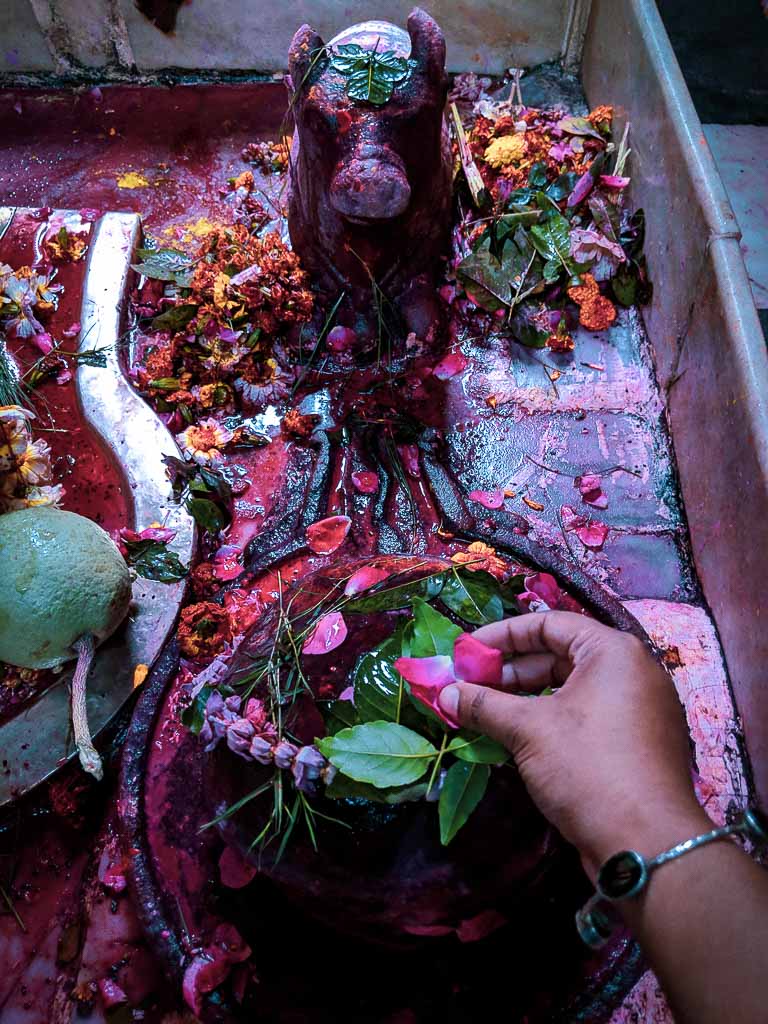
Maha Shivratri
“This is Baba’s home!” Told me a local referring to Shiva as Baba, the father. From the first smearing of Abeer to Bismillah Khan’s Shehnai, everything is for Him, by Him in Varanasi! The faith is inexplicable in words.
Maha Shivratri is celebrated in the month of Falgun (Hindu calender) to commemorate the wedding of Shiv-Parvati, the unison of creation and nature. Needless to say, the celebration acquires an unprecedented stature of Grandeur! In Mauritius, Maha Shivratri is celebrated with equal pomp!
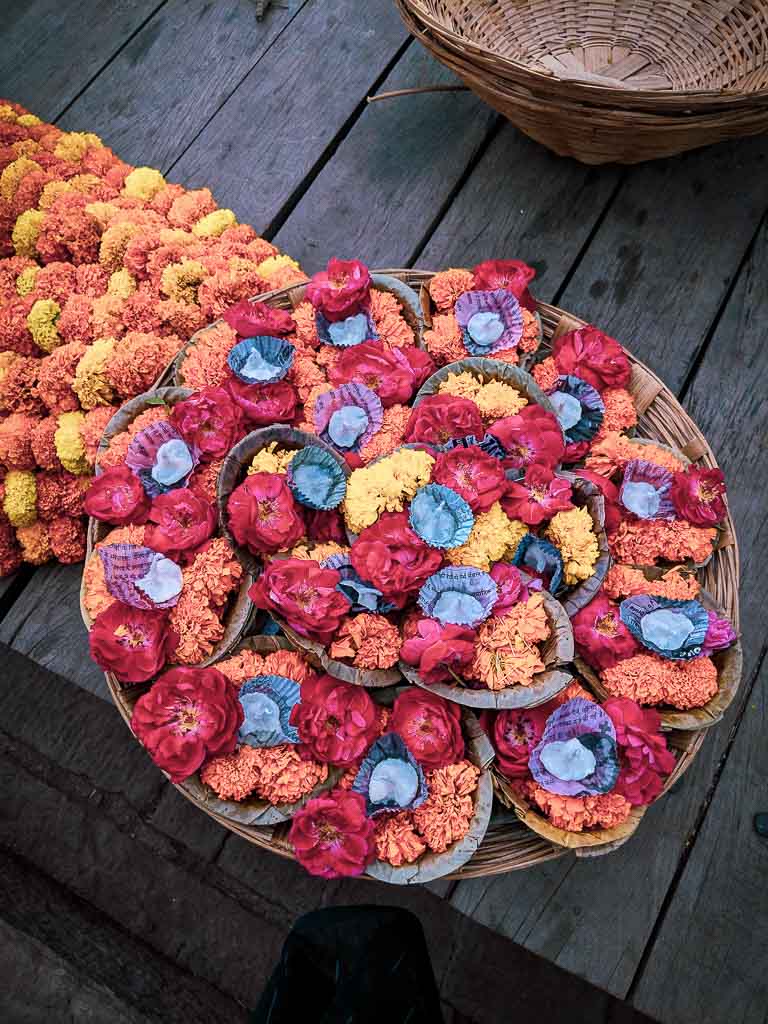
Holi: Spring Festival of Color
Holi is Varanasi starts with smearing abeer and milk on the Shiv Linga. Ideally, you would wanna be close to Kashi Viswanath temple but I visited one of the smaller temples close to my hostel. Afterwards, people take it to the streets and celebrate holi with smearing color to each other! Bhang is prepared in humongous buckets and distributed to everyone! Streets are awashed with vibrant colors of red, purple, yellow and green!
It is best to celebrate Holi with people you know if you want to stay away from strangers violating personal space in the guise of a festival. I do!

Dev Deepavali
Under a full moon night, the ghats of Varanasi decks up with millions of Pradip (oil lamps on earthen pot) to celebration homecoming of Ram after he has defeated Ravan of Lanka, as depicted in the Indian epic Ramayana. It usually co-insides with Ganga Mahotsav, taking place over 5 days with various activities performed as an ode to the river Ganga. Boat race, art and craft fare and display, decorations and floating diyas on the water are some parts of it!
Every Other Day is a festival in Varanasi. It is the way of life here. Not every festival is as big as a Deepabali or Shivratri but there are millions of people in the city at any given point of time. Many of them are pilgrims. I suggest look for these small celebrations taking place at the smaller temples and be a part of it (if you want to).

Day trips from Varanasi
For me, it was hard to part away with the streets of Varanasi and the Ghats by Ganga for making the day trips from Varanasi. But I understand the moments your heart longs for solitude. Mine does once the initial amazement cede down.
Just not Varanasi, there are many other historic places of interests in nearby area which are great for making quick day trips from Varanasi. History in these parts date back to thousands of years as well.
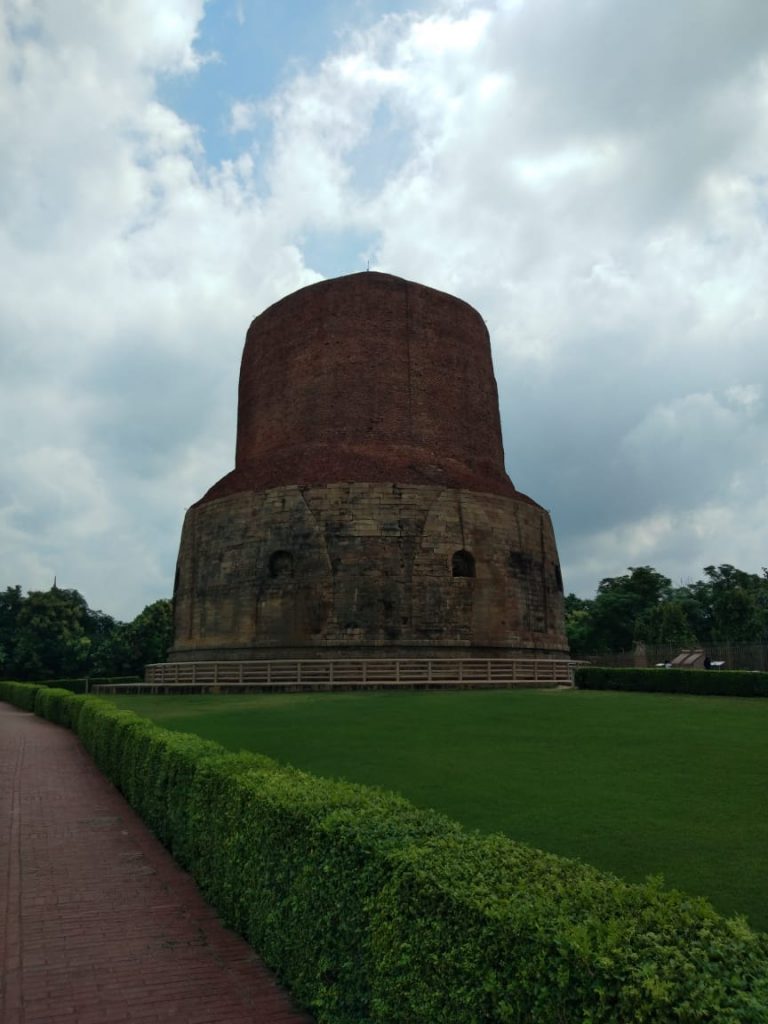
Sarnath
The UNESCO world heritage site of Sarnath is one of the most important pilgrimage sights of Buddhist community. This is where Buddha had preached his first sermon. At a distance of 10 KM from Varanasi, Sarnath receives plenty of footfall all the year around. In olden days, Sarnath was known as Isipatana. Sri Digambar jain temple is located closeby as well. The Lion Capital of Ashoka, revered as the national emblem of India, is housed at the Sarnath museum.
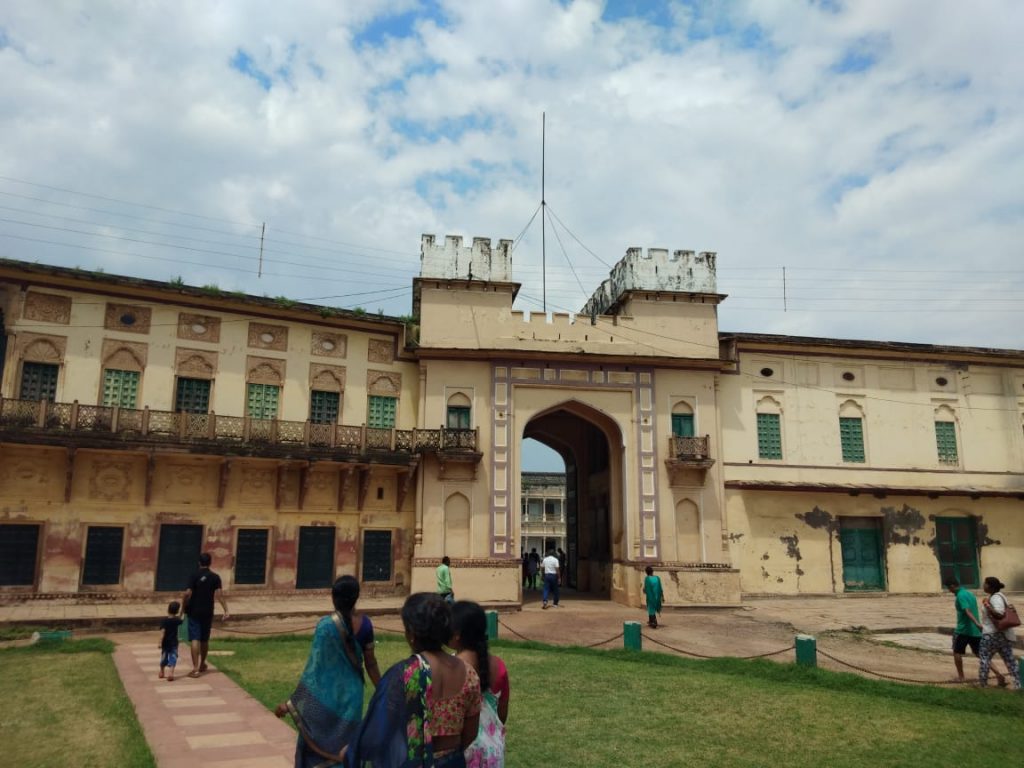
Ram Nagar Fort
Built in eighteenth century, Ram Nagar fort is a decaying architectural marvel on the eastern bank of Ganga. Intricate art work and beautiful paisley motifs adorn the walls of this old world gem. It is located at a distance of four km from Assi Ghat. Dust and ill maintenance are prominent everywhere, slowly eating away from the grandeur that the Ramnagar fort once flaunted!
Chunar Fort
If you love forts, drive for approximately 30 km towards east and reach the famed Chunar fort by the banks of river Ganga in Mirjapur. Made of sandstone, Chunar fort has its history dating back to Sher Shah Suri’s reign. Legend says, God resides in the Chunar fort for 9 hours a day and spend the first half (from 6 am to 9 am) at Kashi. If you want to conquer the fort, plan your attack accordingly.
Dudhwa National Park
A tiger reserve at the Himalayan foothill, the diverse acosystem of Terai grassland of Dudhwa are stunningly beautiful. While your chances of spotting an animal is miniscule compared to Kaziranga or Chitwan national park, visit Dudhwa if you want to experience nature at her best! Though Dudhwa is not exactly a day trip from Benaras. You need to plan a stay there at least for a couple of nights.
Rajdari and Devadari waterfalls
Devadari and Rajdari waterfalls are located at Chandauli (60 km from Varanasi). Rajdari Waterfall is a scenic picnic spot at the foot of a cliff. Devdari Waterfall is set amid cascading white water flow and lush green canopy. This is located close to Chandraprabha Wildlife Sanctuary.
Tenda falls
At 80 km distance from Varanasi, you come across a gorgeous fall named Tenda. Located at Mirzapur, Tenda falls look pretty in the monsoon.
Beyond Varanasi
If you have fallen in love with the vibes of Varanasi, head out to a few more destinations in India. They are famous as ancient human settlements. Spirituality and a tryst with divinity are the orders of the day for a large part of Indian subcontinent. Along with that, you will find an astounding population of thriving millions, co-existing with diverse lifestyle within the realm of a shared valley!
More places like Varanasi in India: Hardwar, Rameswaram, Amritsar, North Kolkata, Kamakhya (Assam), Tirupati, Ajmer Sharif.
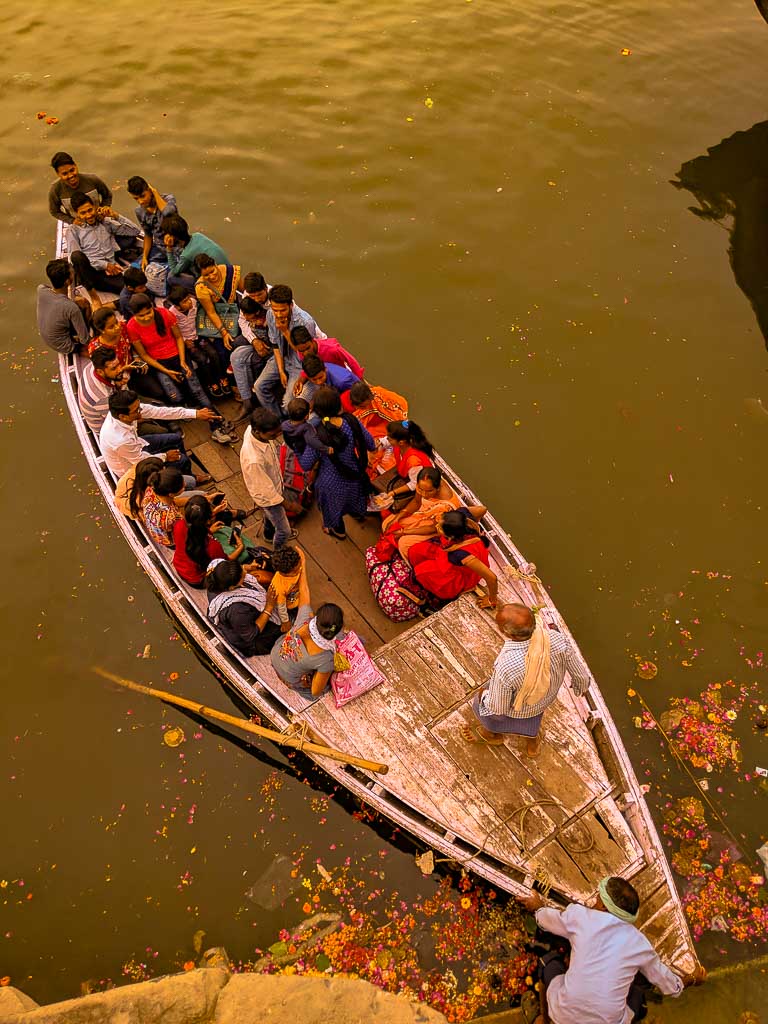
Best Time to Visit Varanasi
The dry and cold months from late October to Early April are the best time to visit Varanasi. October being the start of Great Indian festival season, you will come across one after another celebration at Kashi, with Dev Deepavali being the most prominent of them. In March, Indian spring, you might have a chance to experience Holi! Besides, winter is the only time you get a change to taste legendary Malaiyon! Definitely visit Varanasi in the dry months of Indian winter!
Summer in Indian plains is excruciating. During rainy season, incessant downpour swells up the river Ganga and fills the roads with murk and filth. Avoid both the season.
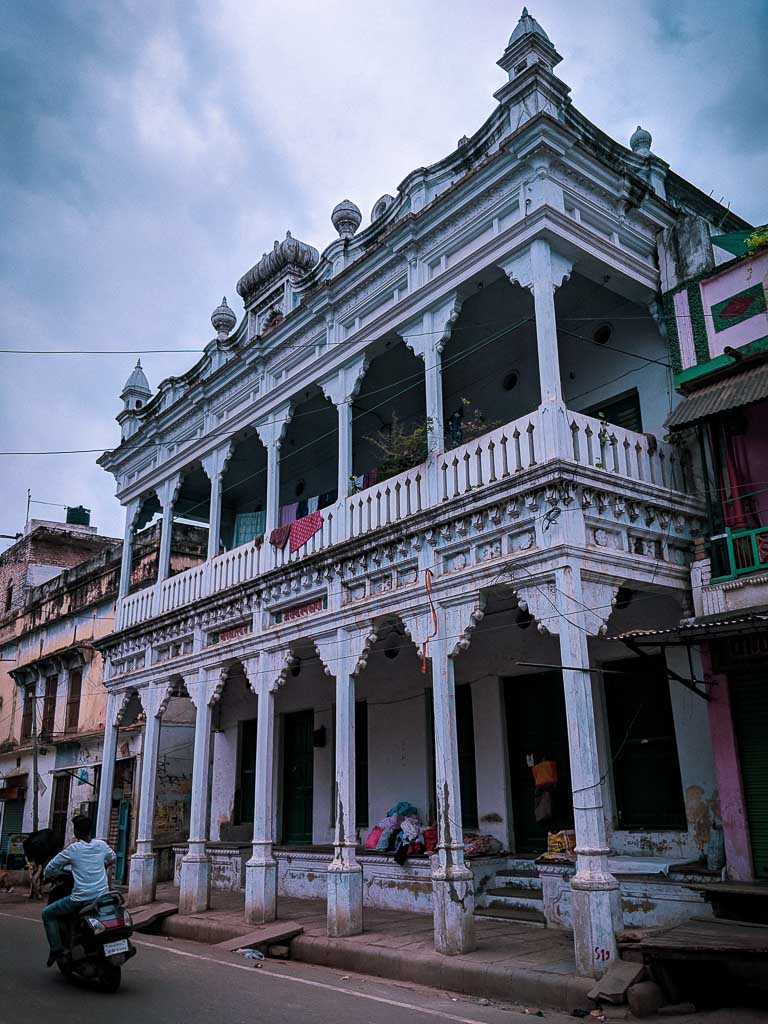
Tentative cost of Varanasi Travel
By the virtue of being a Hindu pilgrim spot, Varanasi is delightfully affordable. A stay in Varanasi can be booked for as low as 300 rs. Considering you shall be exploring the city for the better part of the day, it makes sense to spend thrifty amount for a hotel. For a decent stay, expect to shell out INR 1500.
Meals in Varanasi come for as low as INR 50. Vegetarian. Contains rice and lentil and chapati. A glass of lassi would be anywhere close to INR 25. Same goes for commute, considering rickshaws will charge you less than INR 30 for short ply.
There is no reason why you can not make a successful trip to Varanasi for three to four days within INR 2000. Please count the cost of hotel or guest house as an add on.
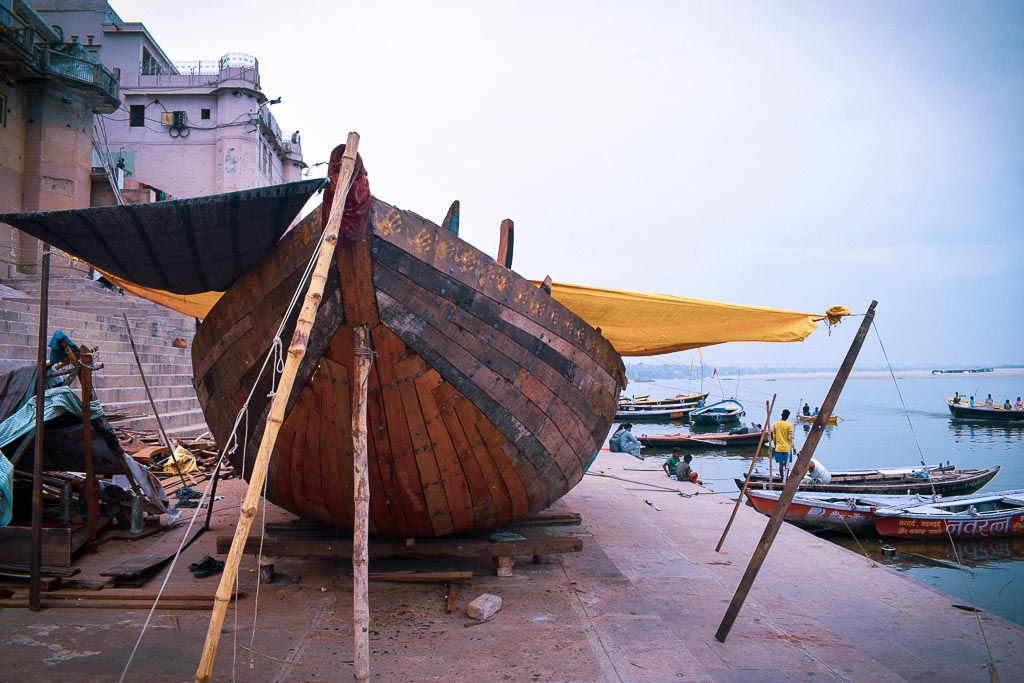
Responsible Travel Tips in Varanasi
If you do not understand a ritual, it is okay!
Wearing a shoe, I had entered a milk shop that was also selling Rabdi. the owner frowned. I had no clue. At the end, he pointed towards my feet and asked me to remove shoes outside the shop. I compiled and asked for reason. he said the milk would curdle otherwise.
I understand that is a possibility with dust but coagulation is possible with a large open door as well, not just my shoe!
This is one of the many examples of specific local rituals that are integral to everyday life in Varanasi. I did not understand many, but I did not press reason either. That made locals happy!
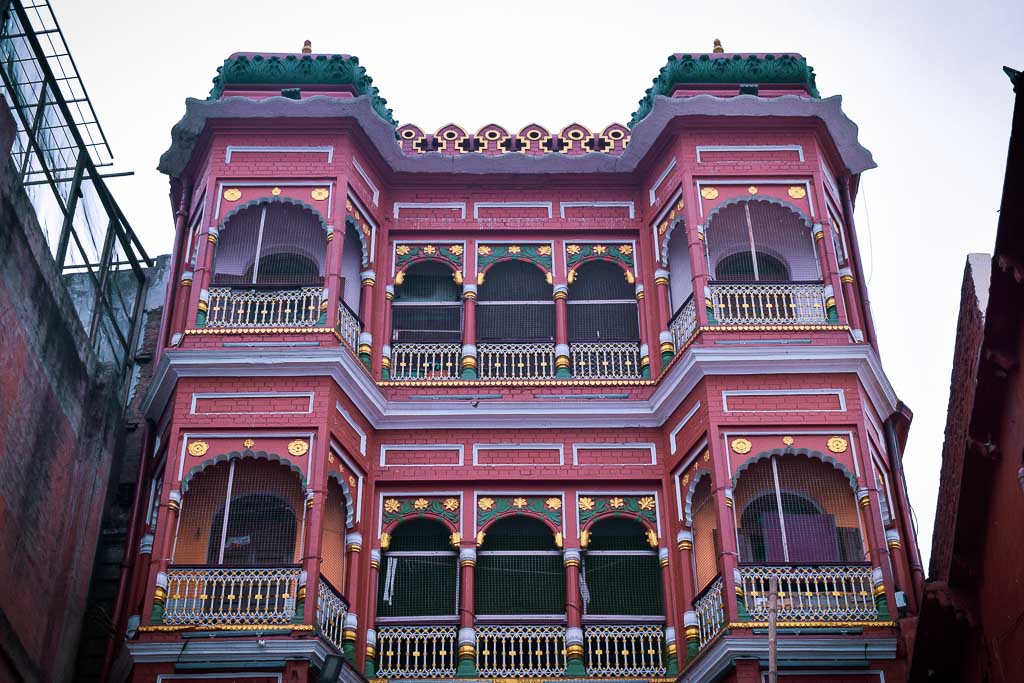
Mutual respect will take you further
Respect the locals! I can not stress on this further.
Respect for food, dress, customs, dialect, rituals, customs should come unchallenged.
Varanasi as a city has survived insurmountable surges in History and the river stood witness to all of it. It is best to accept her with the follies and get on with it.
Be Mindful of Photography
I have noticed men sitting at the ghats with a camera and shooting men and women taking baths in the river. Please know, this is not acceptable in the prevalent culture. If you are going to shoot the naga sadhus, you need to pay a small fee. Photographing any sadhu translates into a small fee.
The most delicate subject of photography in Varanasi is the cremation ghat, Manikarnika. You must not click the camera shutter unless you have got explicit permission.
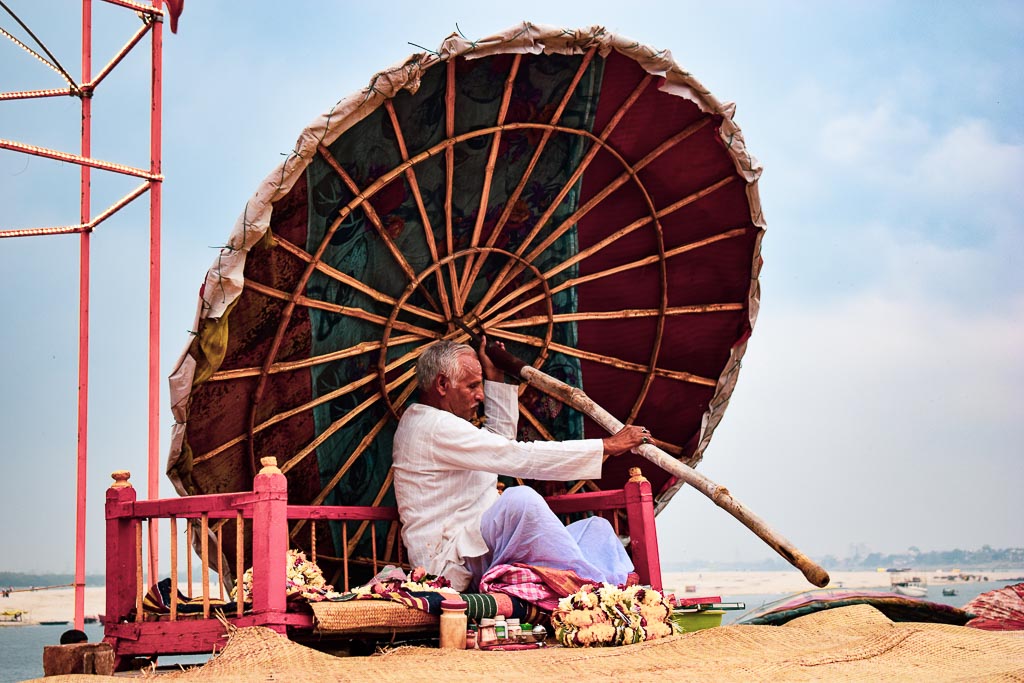
Namani Gange
Namani Gange is the new project run by Indian Government to clean up the river. I doubt if that had any impact on the river in Varanasi in particular, but substantial research and efforts have been budgeted to clear the most sacred river of the country. Before you throw a plastic cup (which is a punishable offence if you get caught) or float the candle, think twice. You are jeopardizing efforts by countless researchers at work trying to safeguard a majestic and crucial natural resource.
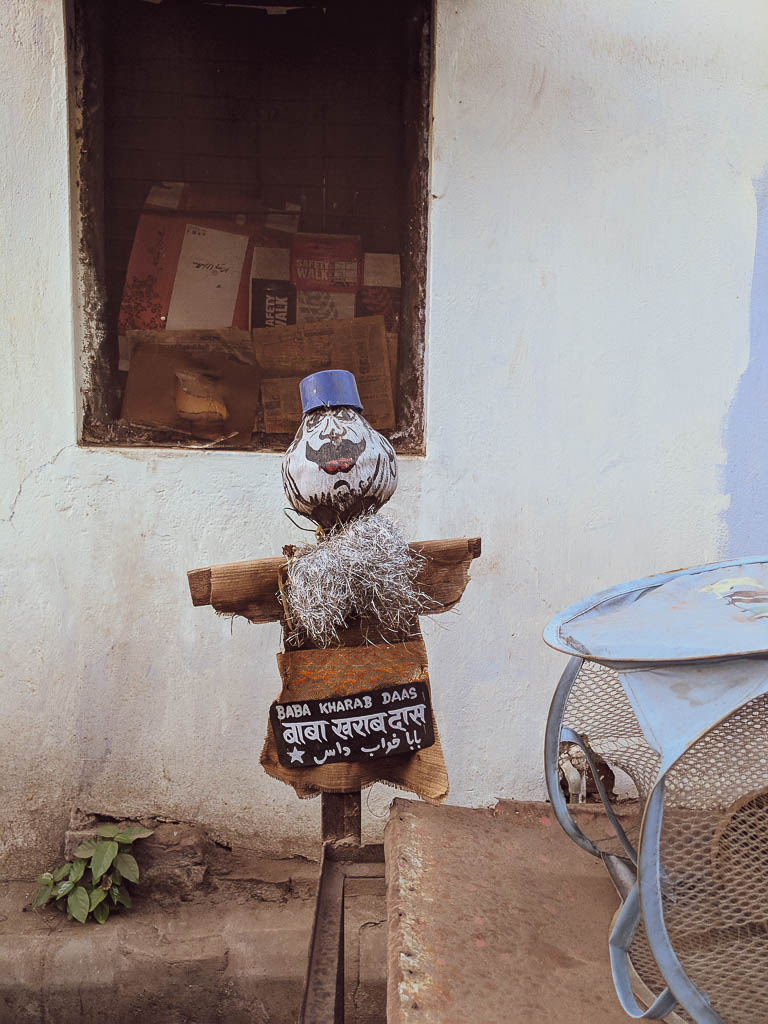
Nightlife in Varanasi is nowhere close to usual partying!
Varanasi is not the place to party in real sense, though it is possible to stay out till lake at night and explore the ghats of Ganga. There is no pub or bar to spend the night in true sense. However, like the rest of the day, night is eclectic and full of excitement in Varansi as well.
Smoking Weed in Varanasi (Can be problematic)
Smoking weed or use of any drug is strictly illegal in India. Bhang, Charas, Ganja all come under the same bracket. Kindly refrain from these practice even when you see a Saadhu indulging in such practice. Law is not going to be kind to you. It is “different” for Sadhus!
Modest Clothing is your best friend in Varanasi (and in India at large)
Since Varanasi is the capital of spirituality in India, be advised to dress appropriately. I wore a saree and a salwar suit on all my days in Varanasi, to avoid uncalled for attention and prying male gaze. That usually works but only so much. A dress covering shoulders, thighs, arms and chest is an imperative garment while visiting the temples.
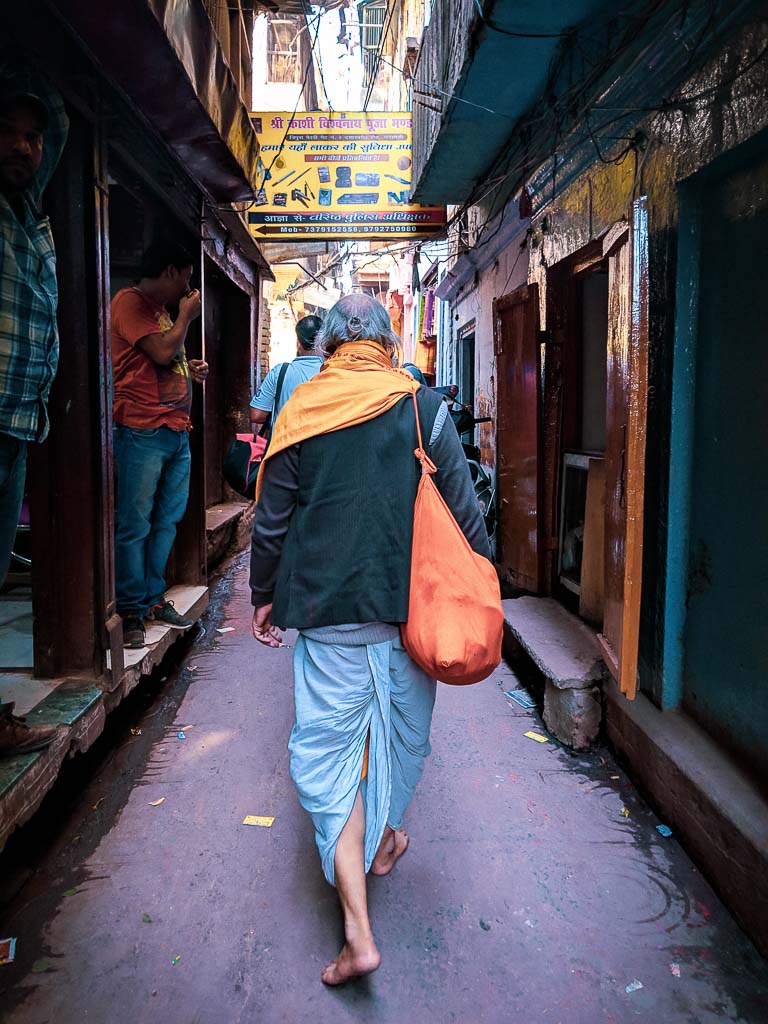
Safety tips
I traveled solo in Varanasi, on the eve of Holi festival and I felt safe barring a few stray incidents. It is imperative to plan meticulously to ensure you are aware of the possible bitter experiences and can cycle around them.
Should Varanasi be your first stop in India?
Many suggest not to make Varanasi the first stop during your trip in India. Well, I am an Indian born and raised yet I felt overwhelmed in Varanasi. I understand what can go wrong if you make an uninformed trip.
However, with an educated and well informed trip to Varanasi, you will be somewhat prepared to face Varanasi. Her eccentric street life, wise sadhus, mean touts, rabid dogs, delectable dairy sweets, meandering through cow dung… You get the drift.
I believe nothing can ever really make you prepare for Varanasi. She is an idea you need to fall in love with first, then start to explore. With a city whose history goes back to 3000 years and more, what is not to love in the first place? This is more relevant if you are a cultural traveler.
Guided walking tours
A guided walking tour to explore the streets of Varanasi and her numerous cultural nuances is the safest way to dodge the crowd and touts. Also, you do not have enough time to get lost in the lanes of Varanasi and come out victorious of the labyrinth. Ask your guest house for a reliable local guide or a guided tour company.
Watch the water level of Ganga
Before you decide to go for a boat ride, watch the water level of Ganga. During monsoon, the river crosses the ref fags and possess an imminent threat of flooding. Boating may be cancelled on certain days of incessant rains. While locals do go for swimming in Ganga, I would say be cognizant of the fact that many half burnt dead-bodies are thrown into the river, which flows downstream (where you are likely to swim). It is not at all hygienic. I saw faithful families making their infant children take a dip in the river. My heart shrieked!
Touts and scammers everywhere
“Where are you from?” is the usual pick up line of the scammers in Benaras. This is applied generously irrespective of your sin color. I can not believe this but a tout approached me right inside the Garghagriha of a temple and tried to con! It was sad to see Varanasi being infested with the scammers but learn to say no whenever a man pushes for for the elusive, “best view”, “best aarti”, “best puja” experience.
The Naga Sadhus
I thought nudity is not socially or legally accepted in India until I came across the Naga sadhus. A sect of Hindu monks who primarily resides in the high mountains of Himalaya, the Naga sadhus are known to be fierce warriors, “protectors of the realm”.
When I was visiting Benaras, the Ardh Kumbh mela was due. A stretch of the ghat close to Harishchandra ghat was reserved for makeshift tents by the Naga sadhus. Ash clad, flaunting Jata (matted hair braids), and not a string of cotton on their body, Naga sadhus are visibly intriguing. I was told not to approach them alone. I did not have any intent either.
However I saw a white woman, with her boyfriend, sitting by the tent of one such naga Sadhu, speaking to him and ringing a bell that was attached to his penis. I try to speak from a neutral standpoint, but I have to unlearn a lot of value system till I could unsee that scene.
Beware of used knife while getting a haircut
It is tempting to sit by the ghat and get a haircut by the “Khourokar”, the professional barber in Varanasi as a pleasant breeze caresses your ears. Many children get their first haircut by the riverside. If you plan to join the group, please bring your own blade to steer clear of STD and other diseases.
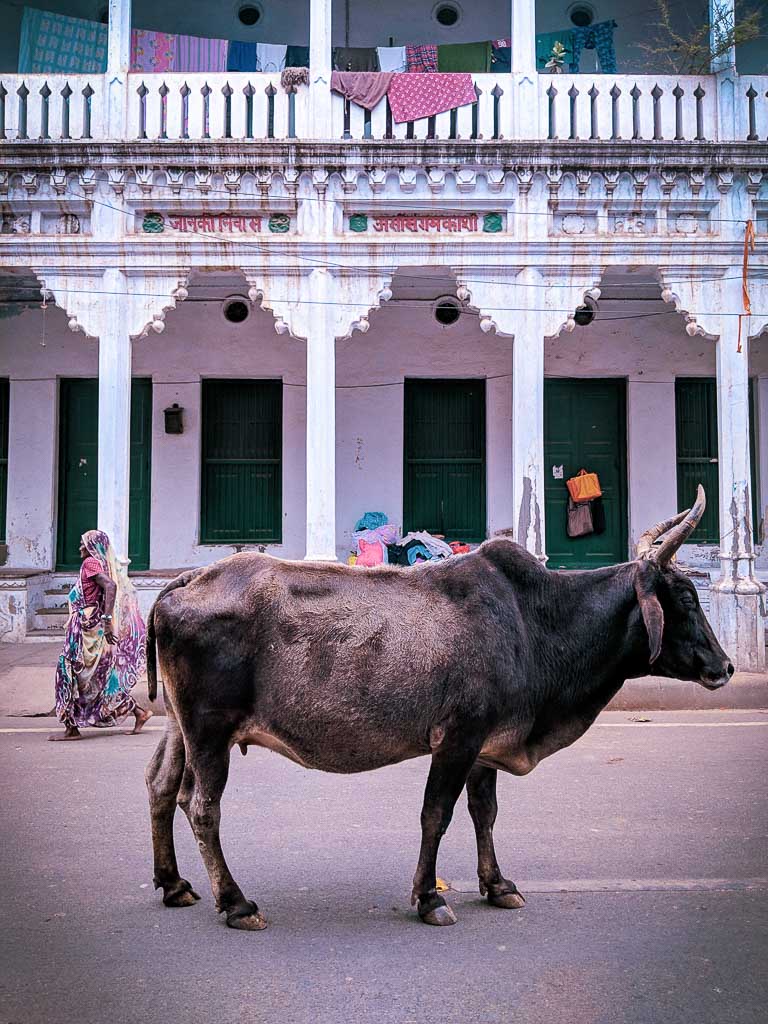
Bulls of Varanasi
209. I counted the number of bulls I met in Varanasi. Bulls and cows and calves. And their myriad moods. Some sat by the river bank regurgitating, some explored the old lanes of Varanasi in slow pace, some sat right in the middle of the road. They are loved and they know it!
While I never had any unpleasant encounters with bulls (also worshipped as the Bahan of Shiva), many complain about angry bulls pushing them against the wall. I know my mom did! Beware and avoid!
Dog bites
Not just Varanasi, the issue with stray dog is rapidly growing into a menace in many destinations in India. More than 30,000 people die in India due to dog bite. Please keep that in mind. There are few neighborhoods in Varanasi with extremely hostile stray dogs. Chalk out your route to avoid such encounters.
Suggested Reading List
Needless to say there are countless books and literary references drawn on Benaras. I will list a few books and movies to watch before you plan on visiting Varanasi.
- Kaleidoscope City: A Year in Varanasi Piers Moore Ede
- Banaras: Walks Through India’s Sacred City
- Living Banaras: Hindu Religion in Cultural Context
- Varanasi at the Crossroads: A Panoramic View of Early Modern Varanasi and the Story of Its Transition Medhasananda
- Banaras: City of Light
- Banaras, the City Revealed
Movies based on Varanasi you should watch before your trip:
- Masaan
- Water
- Raanjhanaa
- Chokher Bali
- Jay Baba Felunath
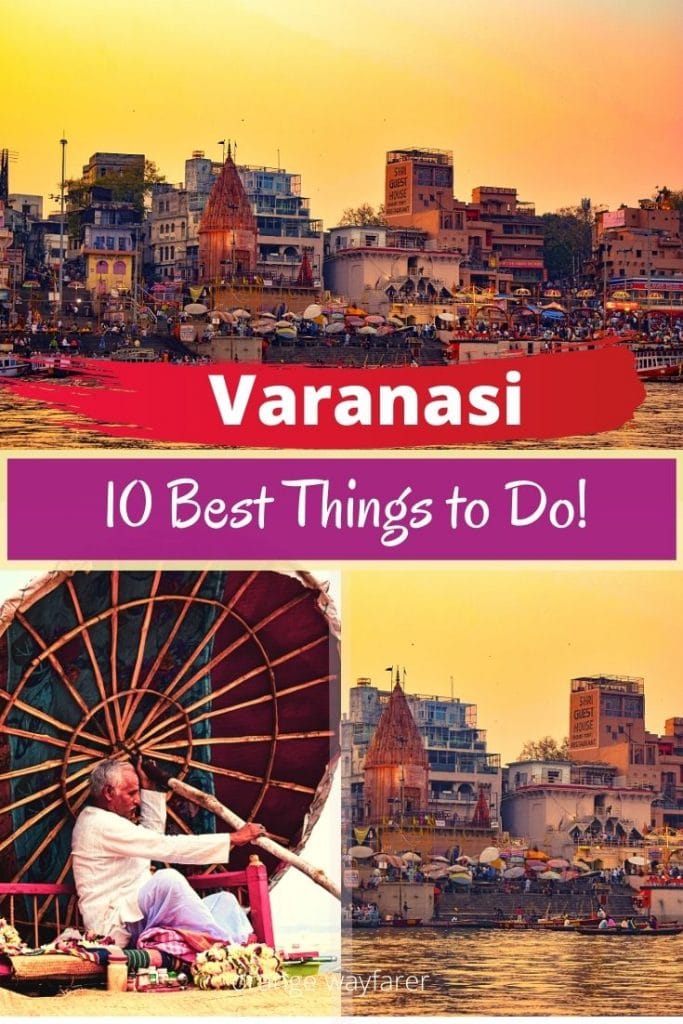
This post may contain affiliate links. Please read the disclosure post. If you have liked the article, you may support it by buying using these links without any extra cost to you.
Let’s stay connected on Facebook, Instagram, Twitter! You may also consider joining my mailing list. I send travel and photography related emails only once a month!
I love so much this place. Thank you so much for shaing this article on your blog.
This is such a beautifully written article. I felt as if i am reading a beautiful novel.
Wonderful Blog! Varanasi is probably the best spiritual place for traveling. Thanks for sharing Such great Information.
Great blog! I am planning to visit Varanasi very soonIt will help me to see maximum important places within a short time. Thanks a lot.
What a beautiful blog post! So comprehensive and informative. I plan on visiting Varanasi soon and this detailed account helped me immensely…I took notes too. Thank you very much!
Nice post. As an resident of varanasi i can say that u have mentioned all info on it.
Keep up the good work.
All the best.
I travelled Varanasi Last Month. This voyage was indeed the journey that brought a new life into me. I was able to find who I was. I’ve written my personal journey of rebirth and rejuvenation here – https://theblogera.com/our-sacred-voyage-to-varanasi/
Varanasi, one of the world’s oldest continuously inhabited cities, boasts a rich tapestry of history and spirituality. Nestled on the banks of the sacred Ganges River, it serves as a spiritual epicenter for Hindus. The city’s history dates back over 3,000 years, contributing to its diverse cultural heritage. Tourists flock to Varanasi to witness its ghats, ancient bathing steps, and experience the mesmerizing Ganga Aarti, a ritual of light and sound. The narrow alleys of the Old City offer a glimpse into traditional life, with vibrant markets and centuries-old temples. Pilgrims seek spiritual solace at Kashi Vishwanath Temple, dedicated to Lord Shiva. The city also hosts the revered Benaras Hindu University. Varanasi, a hub of classical music and dance, celebrates numerous festivals, adding to its allure. A visit to Varanasi promises a unique blend of history, spirituality, and cultural vibrancy.
I must say that u have included all the important places to cover in Varanasi.
It’s a detailed and i must say that it’s complete information for those who want to visit Varanasi.
Many congratulations and keep the good work.
Reading this article of yours is an exhilarating experience. I have spent some time in Varanasi have seen and experienced several aspects of it but after reading your article, I can say that I had missed several facets of this fantastic mystic city. Everybody, eager to visit Varanasi, must go through this write up to enjoy Kashi darshan. And another most interesting part of your blog article is the bunch of photographs…. really amazing… keep posting such a brilliant blog.
Thank you. You made my day…
Beautiful description! The way you compared Varanasi to visiting grandparents really paints a picture. I especially loved the detail about the “golden house geckos.” Makes me want to experience it for myself!
Wow, this blog beautifully captures the essence of Varanasi! The vivid descriptions of the ghats, temples, and the mesmerizing Ganga Aarti transport me right to the heart of this ancient city. Your insights into the cultural and spiritual significance of Varanasi are truly enlightening. Can’t wait to read more about your experiences and tips for exploring this incredible city! so I also try to write a blog about Varanasi anchor text here so you can also visit .
thank you